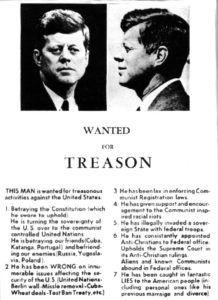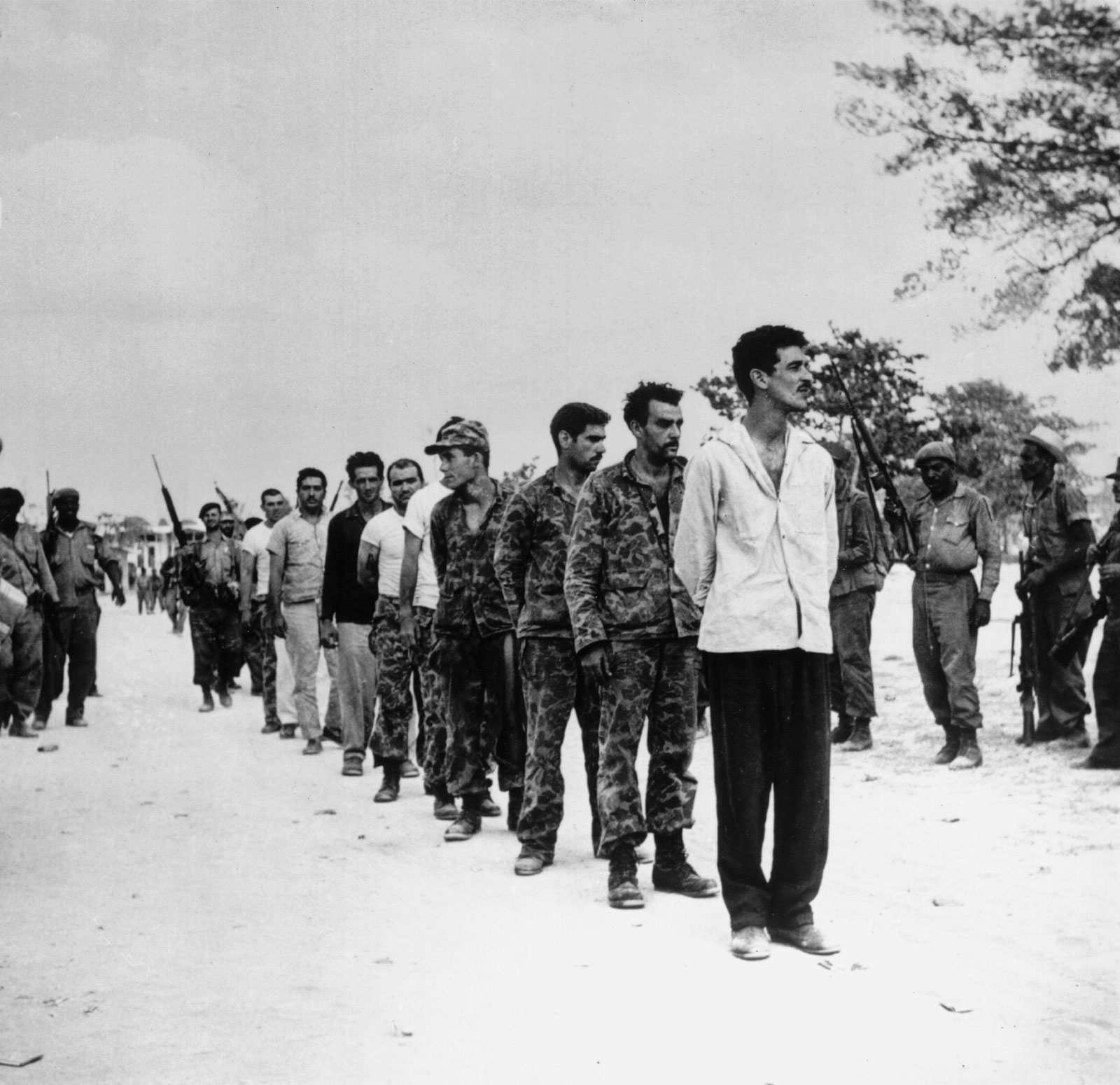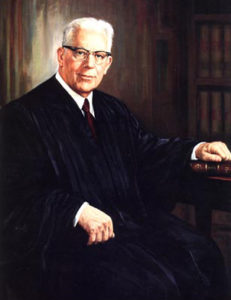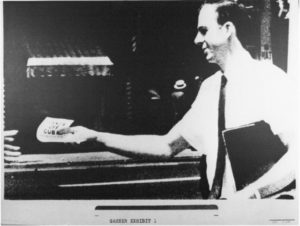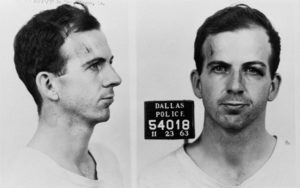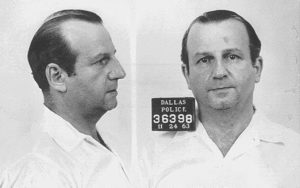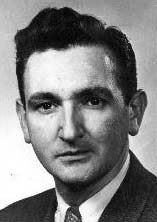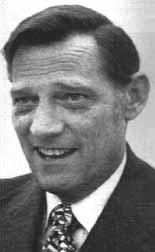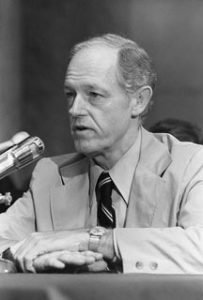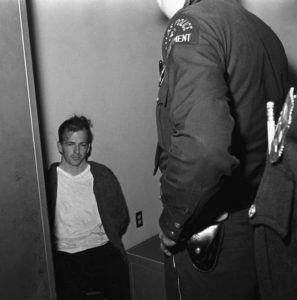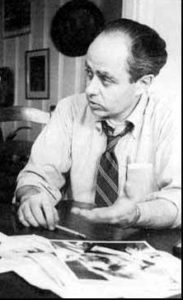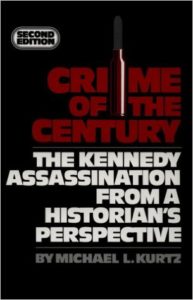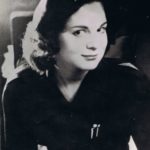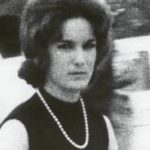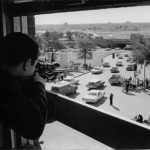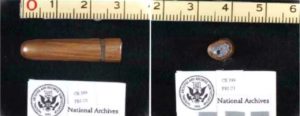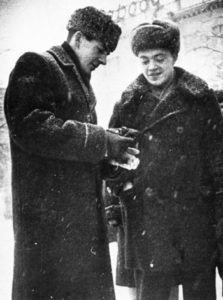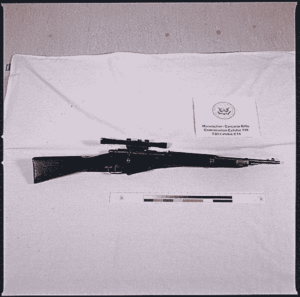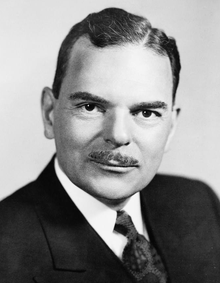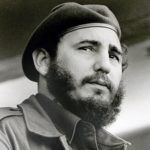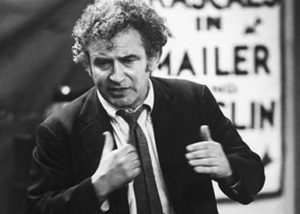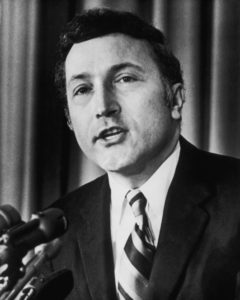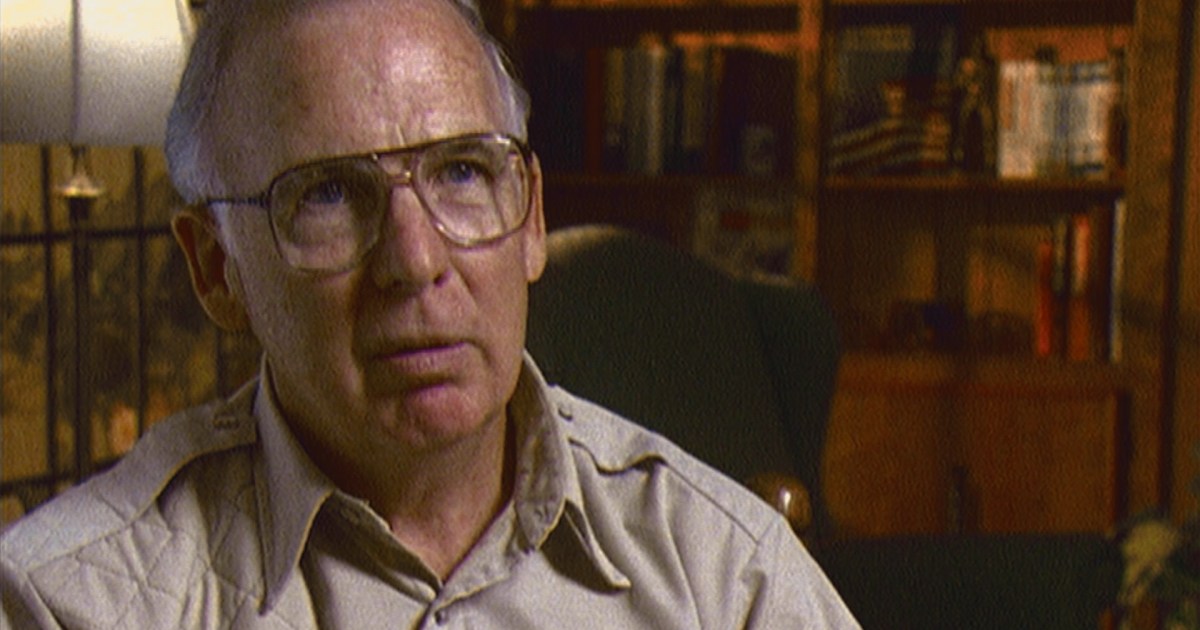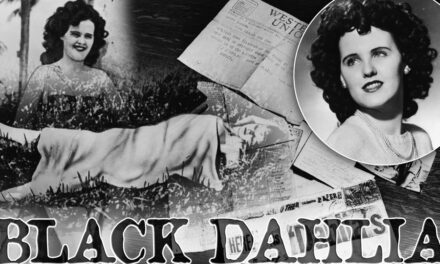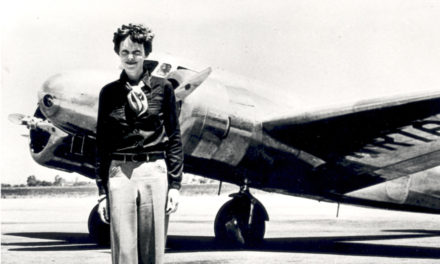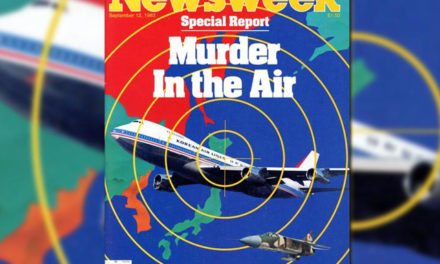JFK Assassination
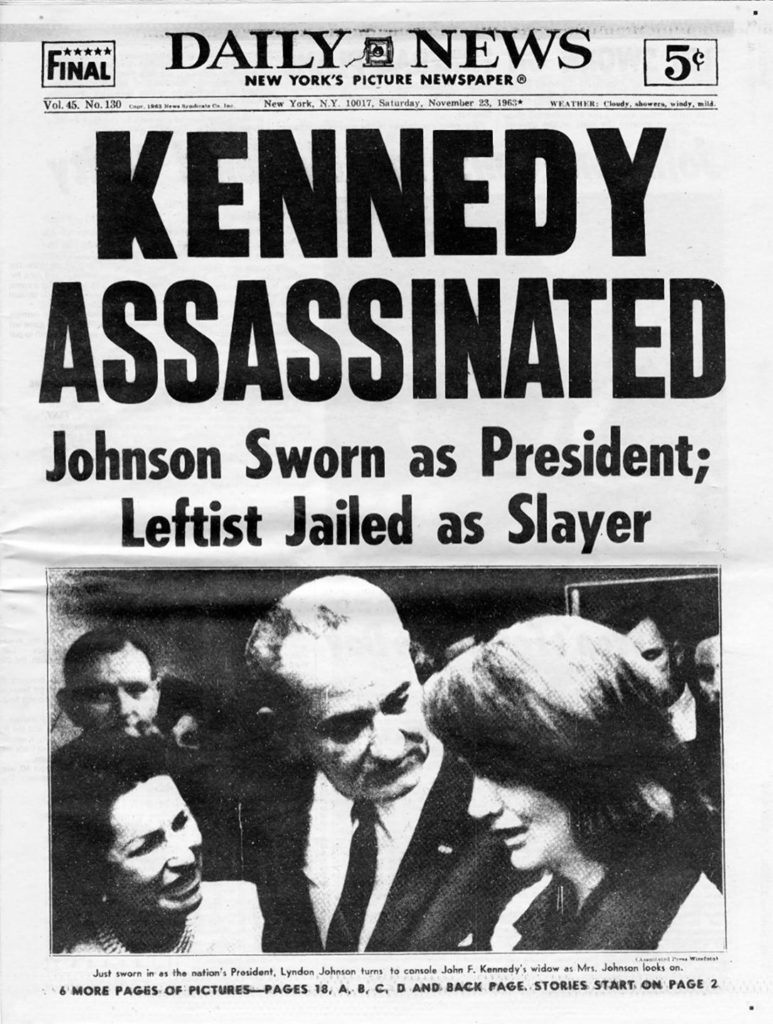 Those of us who were alive then, we all remember where we were on November 22, 1963. The murder of a young, vibrant President was a defining moment of the era, and echoes to this day.
Those of us who were alive then, we all remember where we were on November 22, 1963. The murder of a young, vibrant President was a defining moment of the era, and echoes to this day.
After over half a century of controversy concerning the whole story, and hundreds of books, JFK’s death is the grandfather of all murder mysteries. Naturally it must be addressed by Mind Over Mystery.
We will not necessarily crack the code, put an end to the speculation, or write the 900th book on the subject, but we can help illuminate promising avenues to analyze. We can help separate the wheat from the chaff. In many ways, the most interesting parts of the mystery are the sidebars: careers changed forever by proximity to the tragedy, and entire careers devoted to Kennedy Assassination Studies, to chasing ultimate, perhaps unknowable answers. Then there’s the mystery within a mystery of Jack Ruby, whose world was connected to people who hated Kennedy. Yet he supposedly become so enraged at the murder that he, in turn, murdered the alleged sniper.
Most of all there’s the specter of respectable public figures, from Walter Cronkite to Earl Warren, losing credibility as much of the public concluded they had not been told the truth, and the whole truth, about Kennedy’s death. That tragic day in November was followed by sad days for years to come, in which numerous public servants lied into the faces of those they were supposed to serve.
What happened with the murder, the aftermath, the investigation, the media? Mind Over Mystery will try to shed a little light into the darkness.
SEVEN SECONDS IN DALLAS
To review the known facts, President Kennedy was riding in the back seat of an open limousine through downtown Dallas, the better to wave to and feel intimate with the crowds surrounding the motorcade. Jacqueline Kennedy, in a pink suit etched forever into public memory, sat beside him, and Texas Governor and Mrs. John Connally sat in front of them on jumpseats placed a few inches lower. The limousine had just turned from Houston Street onto Elm, and proceeded, at roughly 11 miles an hour, through the last, short stretch of downtown, only a couple of hundred yards away from going under an overpass onto a freeway and then cruising at greater speed to the next destination.
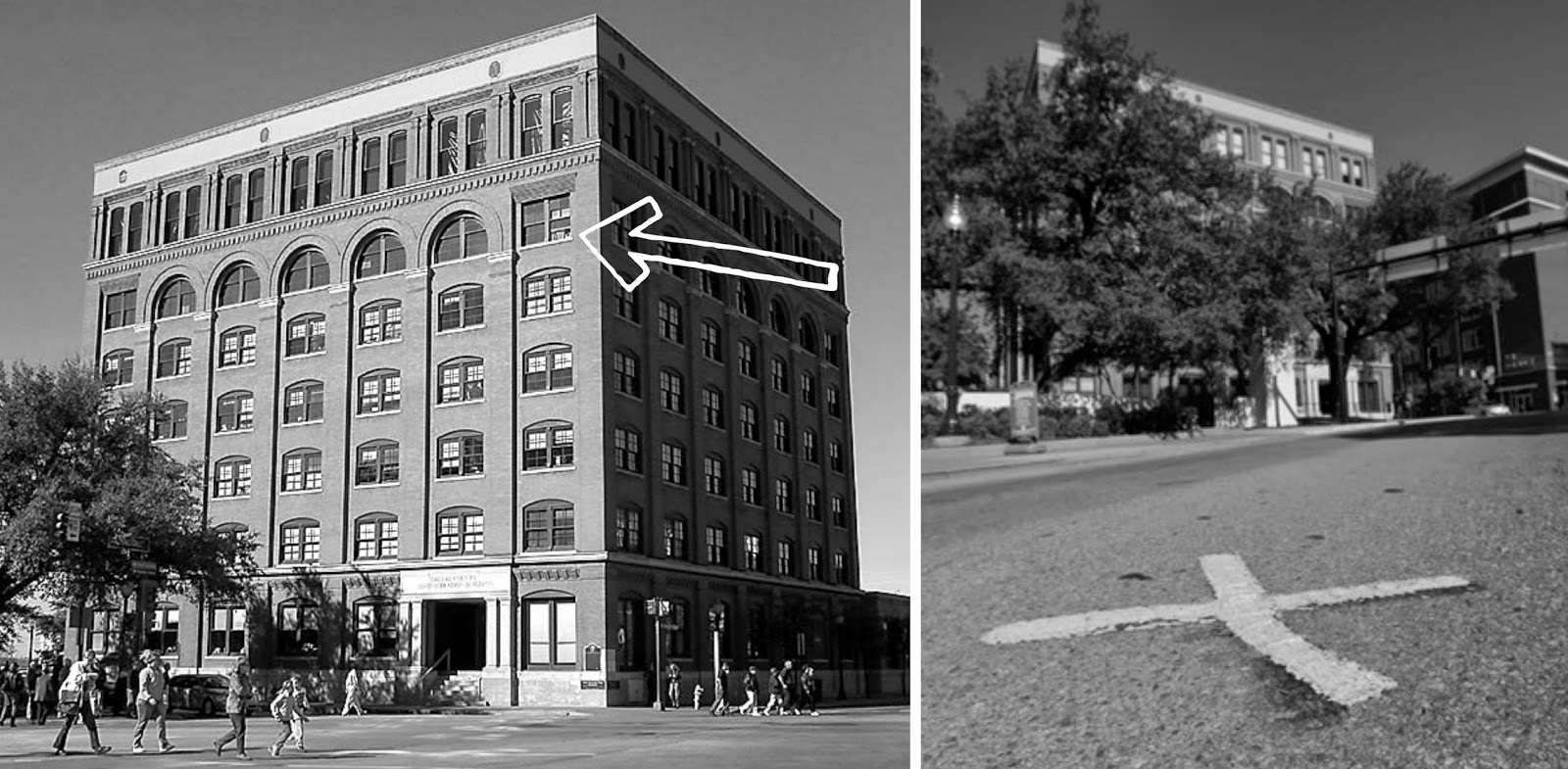
Dallas School Book Depository Building – Left – Arrow pointing to the window in which the shots were fired. Right – The “X” showing where the President was hit with open window in the book depository.
Near the corner of Houston and Elm, the sixth floor of the Dallas School Book Depository Building allowed a good, straight line of sight and shot onto the slowly moving vehicle, and apparently Lee Harvey Oswald (an employee who worked in the building) set up cardboard boxes as a shooting platform and fired three rifle shots, in less than eight seconds, at the back of the President. The first, by official reckoning, missed altogether and struck the curb of the street, the second shot went through Kennedy’s throat and on into Connally’s body, and the third hit Kennedy dramatically, and fatally, in the head. It immediately sprayed brain tissue around the car and onto other passengers, ending Kennedy’s life and presidency in an instant. Later, when all other Book Depository employees were accounted for, Oswald was the only one missing. It seems he had slipped out, gone back to his rooming house and picked up his revolver there, encountered and murdered an inquisitive policeman on the next leg of his transit, and finally ducked into a movie theater, where he was cornered and arrested by Dallas police.
Shamefully scant records were made of Oswald’s almost two days in police custody in Dallas. At one point, when reporters had a glimpse of him, he tossed off the remark that he was merely a “patsy,” and according to later testimony constantly denied any involvement with any assassination. The ultimate embarrassment to Dallas authorities occurred on Sunday, November 24th in the late morning, when Oswald was brought to the jail basement for transfer to another facility. Local nightclub owner Jack Ruby, having slipped into the building and maneuvered close to Oswald, shot him fatally in the stomach at point-blank range.
Ruby died in prison, never revealing any motive beyond an overwhelming rage at Oswald, triggering his impulsive act. But because of the two deaths in quick succession, and the constant drum-beat of fact, rumor, and innuendo that surfaced for years thereafter, JFK’s murder has given rise to more speculation, more doubts, and more published theories, than any other in history.
THE BACKDROP, THE SETTING
The young president was a study in contrasts: apparently dynamic and healthy, while nursing more health problems than anyone in high office since FDR. To judge from his personal, especially sexual life in the White House he seemed devoid of morals, yet history judges his interest in moral issues–civil rights, mental health care, education, peace and disarmament–to be intense and sincere. John F. Kennedy was born and lived a man of exquisite privilege, yet came to focus on the underprivileged like few presidents before him.
Many analysts ask the “cui bono?”–who benefits?–question of events like political assassination, the answer to which always raises suggestive observations, but of course proves absolutely nothing by itself. In the case of JFK’s death, “Cui Bono?” yields unusually rich results, for it seems that not one but numerous groups capable of mustering an assassination all wanted Kennedy’s administration over as soon as possible.
There were contrasts as well in the public perception of the president elected by a hair’s breadth: just as it was always “the best of times, and the worst of times,” the charismatic JFK in his time was very much adored, and much feared and loathed. Supporters felt more hope, and more promise in public service, than at any time in generations. Detractors ardently believed that his ascendance to the presidency spelled doom for America, or at least for some of the military and intelligence institutions that provided their livelihood.
When JFK visited Dallas, Texas, on November 22, 1963, he waved to adoring crowds but he was also traveling through the maw of powerful opposition. Many white supremacist, or ultra-right wing anti-communist, or otherwise rabidly anti-progressive groups held sway there. To have Kennedy ride in an open limousine, below dozens of office buildings with open windows and opportunities for sniper placement, was beyond irresponsible. How it could have been permitted rises as a compelling question, if not a mystery of its own, to this day.
Israel’s right-wing as well would have ardently welcomed a change at the head of US government. Although not widely known at the time, JFK was staunchly opposed to Israel’s plans to develop nuclear weapons, while Israeli leadership perceived their nation as fragile, surrounded on all sides by hostile forces, and desperately in need of serious weaponry to maintain sheer survival. Kennedy’s adamant opposition to the nuclear program and other Israeli foreign policy goals was viewed as almost genocidally dangerous to Israel. Three of the groups are really an interrelated cluster: the Central Intelligence Agency of the United States, Israel’s Mossad, and the right-wing branches of French intelligence. (French president Charles de Gaulle, hated by his far right-wing, was to survive assassination plots.) The CIA, much discussed in theories about the assassination for over half a century, had fallen out with Kennedy specifically over the Bay of Pigs fiasco–and his apparent quote that he wanted “to splinter the agency into a thousand pieces and scatter it to the wind” –and more generally over his wish for detente and disarmament vis-a-vis the communist block. Numerous CIA careerists, it is alleged, felt that a continued Kennedy presence in the White House could spell the death of their agency, perhaps even of Western democracies as we know them. They would have celebrated his death as a new lease on their lives.
The complex political landscape of the time, and the way the U.S., French, and Israeli intelligence operated within it are too elaborate a discussion for our purposes here, but abundant evidence suggests that like-minded intelligence agencies cooperated closely, and had much to lose by a continuation of Kennedy power. With no bias or political judgment it’s fair to look closely at those entities in light of JFK’s murder.
Cubans of both flavors, pro and anti-Castro, are much discussed as well in narratives of the assassination. Anti-Castro Cubans felt that JFK had hung them out to dry at the Bay of Pigs, stubbornly refusing to back up the Cuban landing force with U.S. air and sea support, effectively condemning hundreds to die and condemning the overthrow of Castro to failure. Right-wing Cuban exiles who fantasized Kennedy roasting to death over a slow fire were not hard to find, such were the bitter emotions. The Bay of Pigs episode constituted such a miserable political passage for the Kennedys that in fact they explored ways to assassinate Castro clandestinely, leading to another theory: Castro got wind of the murderous plans and launched his own pre-emptive strike, killing the President that day in Dallas.The Kennedy administration was also unusually detested by organized crime, perhaps because ‘the Mob‘ had helped the corrupt old Joe Kennedy fix the election in several key locales, only to see their nemesis Bobby Kennedy made Attorney General in the new administration and launch an unusually aggressive program to “combat” organized crime. Thus the story has always been that top mobsters, burned by a “betrayal” or “double-cross,” were thrilled when Kennedy died, whether involved in the crime or not.
One of the most interesting things about those half-dozen groups is that, under many analyses, the lines are so blurred, the overlap between operatives so pronounced. The CIA after all was the agency that essentially ‘ran’ the anti-Castro Cubans, both as they planned an invasion of their homeland and more generally. Moreover, it’s well documented that in recent decades the CIA has enjoyed close cooperation, for specific goals and missions, with organized crime. Thus allegations involving members of more than one group are not necessarily the ravings of crazy theorists, but suggested by abundant testimony over the years of connections, of practical liaisons, between the various entities.
Add to all that the unprecedented Kennedy take-down of U.S. Steel when they raised wholesale prices in 1962 (he publicly criticized “a tiny handful of steel executives whose pursuit of power and profit exceeds their sense of public responsibility,” adding they had “utter contempt” for the nation) and another group of theorists will add the “industrial complex” to the mix of power centers threatened by Kennedy.
Historians remind us that outside of the U.S., in Europe and elsewhere, assassination conspiracies to change power in government have been common, but lone nuts have generally been the shooters in American history. For all the studies, theories, books, and years gone by, no hard evidence has ever emerged to outline a conspiracy in Kennedy’s shooting. No one has delivered compelling evidence that the alleged assassin, or the man who in turn killed him 48 hours later, were controlled by shadow forces of any kind whatever.
So a sober analysis of Kennedy’s demise may–possibly may, in the end–return to the improbable-seeming but real conclusion that two lone nitwits did all the damage.
If so, why all the narrative above about the numerous groups with exceptional animus for the Kennedy administration? Simply, disparaging and even sarcastic remarks about “conspiracy theorists” often emanate from those who’ve concluded that no conspiracy ever existed. They may well be right, but given the exceptional setting, followed by sloppy investigations and even lies from some government agencies–then, lively, creative theories of the assassination were not only inevitable, but understandable. No one should have to apologize for wondering just what the hell happened, and who was pulling the chains, on the events of November 22nd, 1963.
Yes, it may in the end have just been nuts acting alone. But history does offer another lesson: highly charismatic leaders, who threaten the status quo but can’t be derailed politically, have a shorter life span than the rest of us.
THE INVESTIGATIONS
One of the reasons that the official story of the assassination has suffered disbelief from over half the U.S. population (and an overwhelming majority of the world’s population) is that the investigations themselves, to many, appear suspect. The allegation is that new President Lyndon Johnson needed the issue of JFK’s death taken off the table, politically, well before the elections of November, 1964, and thus created a panel that would present blue-ribbon integrity, pressuring them to yield a definitive report by the summer of 1964. The story of how a sitting Chief Justice of the U.S. Supreme Court could ever be talked into crossing the lines separating branches of government to chair such a commission is worthy of a book in itself. Suffice it to say it was a poor decision by Earl Warren, whose legacy will always carry the taint, perhaps unfairly, of leading a process that’s been roundly criticized from the day it’s “twenty-six volume” report was completed.
The report’s essential conclusions: that an odd-ball, frustrated Lee Harvey Oswald found out with a few days notice that the JFK motorcade route would pass just below the windows of his employment site, smuggled his rifle in to work on that 22nd of November, and fired the fatal shots, working completely alone. His erratic behavior both before and after the shooting, including his abrupt departure from downtown Dallas and the shooting of a Dallas policeman, all seemed to indicate the guilt of a criminal in flight. No evidence of a second shooter, or any conspiratorial assistance with the crime, ever surfaced, according to the Commission. As far as Oswald’s suspicious-looking murder less than forty-eight hours later the Commission asserted that Jack Ruby, known to and very friendly with the Dallas police, managed by a fluke to get close to Oswald and shoot him fatally. Ruby, quite the odd-ball in his own right, was said to be intensely emotional about the assassination, and seemed to believe he would be treated as a national hero after killing the President’s killer, not as some sort of common criminal himself. Bottom line: two tragic and senseless, individual killings, with no evidence pointing to conspiracy. Case closed.
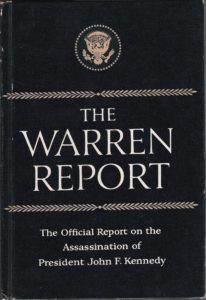
Cover of the Warren Commission report[/captionI
Five of the seven Commission members–those whose signatures consecrated the final product–were distinguished Republicans and the other two conservative, southern Democrats. For many this rendered the appearance of the powerful Establishment reviewing and assessing its own behavior in a time of crisis. In retrospect perhaps a bit more diversity, a respected gadfly or two or a nationally famous defense attorney, would have added credibility to the Commission and its product. One of President Johnson’s appointments was conspicuously inappropriate: that of former CIA careerist and director Allen Dulles, recently fired by JFK. Especially given the inevitable questions about possible CIA involvement with Oswald, or even rogue involvement in assassination plots, appointing the fallen director, dismissed after the Cuban invasion fiasco and possibly bitter at Kennedy, exuded a terrible appearance. It was a foolish, irresponsible appointment by the new President, although it probably made little difference, in the end, to the investigation. Whatever every individual ultimately decides about the honesty and validity of the Warren Commission report, there’s no doubt that a competent staff, driven primarily by respected attorneys, devoted not thousands but tens of thousands of hours to assembling testimony and evidence. The final product may or may not have been flawed but achieved impressive depth and breadth. In general, there was nothing superficial about it, but….There was much widsom in Normal Mailer’s observation that bureaucrats are adept at creating the appearance of in-depth inquiry, when in reality they skirt issues that might embarrass major actors. To Mailer (and many others) it seemed obvious that the commission chose not to rub the nose of FBI, for example, in its many stumbles regarding the Oswald file.
[caption id="attachment_13830" align="alignleft" width="230"]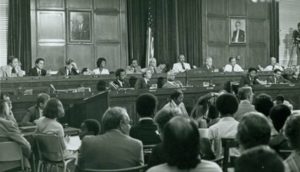 House Select Committee on Assassinations
House Select Committee on Assassinations
Although the HSCA found some minor fault with the original Commission’s focus and methods, it’s core conclusions seemed destined to fully sustain the Commission conclusions until, in it’s closing weeks, an analysis of acoustic evidence convinced HSCA members that four shots were fired that day in Dallas, pushing the logic toward two shooters, and conspiracy. Thus the Select Committee’s published report contained the all-important “C” word, without any clear suspicion of who might have Conspired with whom, although HSCA Chief Counsel G. Robert Blakey figured the “mob” to have been involved. Then, after that huge burst of assassination-intrigue, later analysis concluded that the acoustics were invalid, and the scientific consensus now holds that evidence of four shots does not exist.Informal, citizens investigations began almost immediately, accounting for what would ultimately become hundreds, upon hundreds, of tomes on history’s most analyzed crime. But the book was closed, for a time, on official, government sponsored inquiry. Not counting the Rockefeller Commission’s review of CIA activities which tangentially touched upon some assassination issues, the only re-investigation of the assassination occurred from 1976 to 1978 in the form of the House Select Committee on Assassinations, with Martin Luther King’s demise examined under the same umbrella. It functioned as something of a twelve-year-after review of the Commission’s work on Kennedy’s death, also with a fresh mandate to pursue any new leads or avenues.
Few of those with opinions (or even published books) on the assassination have slogged through the thousands upon thousands of pages of the full Warren Commission report (or the HSCA report), much less attempted to reconcile each exhibit, or section of recorded testimony, with every other available document or supposed fact on the landscape. Scores of people have devoted thousands of hours, in some cases whole lives, to the study of Kennedy Assassination minutiea, and have come no closer to any definitive truth for all their troubles.
If you want to read some of the Mind Over Mystery recommended books and studies, you can find that HERE.
RUBY AND OSWALD
Simply put, the more you study the backgrounds and legends of both Oswald and Ruby, the less they seem like potential participants in any substantial conspiracy. All kinds of investigative/intelligence agencies (e.g., FBI, CIA, KGB, etc.) encountered Oswald in his young life, attention he triggered by such outspoken, eccentric rejection of the United States and embrace of Communism, and the like. And almost universally, the professionals in those agencies concluded, boiled down to the basics: “This kid is a miserable clown, unpredictable as hell and kind of nuts. He offers us nothing, except maybe trouble–let’s keep some tabs on this loony character, but keep him at arm’s length.” Unless all those memos are forged, unless agents from numerous entities all vastly conspired over several years to spread disinformation about Lee Oswald, that was the professional take on him. He was a very strange young malcontent, more nuisance and curiosity than anything else. Everything he had done since he was 17 and had joined the Marines to emulate an older brother had gone badly, pathetically really. He was just about the last person any serious, professional conspirators would recruit for the black operation of the century.
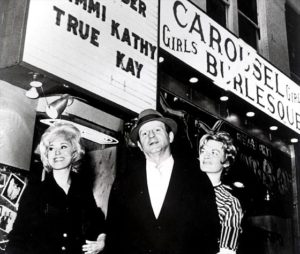 Although he and the older Jack Ruby had vastly different backgrounds, they had ultra-oddball status in common. Jack Ruby functioned well enough to manage a nightclub more or less successfully, but beyond that was temperamental (beat-the-crap-out-of-you-for-looking-at-him-sideways temperamental), unpredictable, indiscreet and even loud-mouthed, and often a bit befuddled, showing no great mental capacities. Sure, gangsters no doubt visited his club and may have been captured in photos, he may have even rubbed shoulders with various soldiers of fortune as he explored the next business racket, which he was always doing. But serious participation with organized criminals–no way, they wouldn’t have told him anything important. As one analyst slyly put it, if Jack Ruby was a member of organized crime, then organized crime needs a new Personnel Director.
Although he and the older Jack Ruby had vastly different backgrounds, they had ultra-oddball status in common. Jack Ruby functioned well enough to manage a nightclub more or less successfully, but beyond that was temperamental (beat-the-crap-out-of-you-for-looking-at-him-sideways temperamental), unpredictable, indiscreet and even loud-mouthed, and often a bit befuddled, showing no great mental capacities. Sure, gangsters no doubt visited his club and may have been captured in photos, he may have even rubbed shoulders with various soldiers of fortune as he explored the next business racket, which he was always doing. But serious participation with organized criminals–no way, they wouldn’t have told him anything important. As one analyst slyly put it, if Jack Ruby was a member of organized crime, then organized crime needs a new Personnel Director.
So the longer and closer you examine the lives and track records of both men, the less and less logical it seems that any substantial agency, the FBI or CIA for example, would want much to do with either of them, beyond receiving any information they were willing to offer. Oswald for his part was active in his pro-Castro activities, the Fair Play for Cuba Committee and the like, but he was often a committee of one, working essentially alone handing out leaflets. He was in fact the quintessential loner who got along with almost no one, and everyone who lived with or near him stresses how much time he spent in his room alone, how relatively little he circulated in the community.
He did fancy himself a player who could go undercover for a good cause, and apparently attended some anti-Castro activities as a way of gathering “intelligence” on the other side, though who if anyone he would have shared this intelligence with is not clear. In one of the most celebrated incidents in JFK assassination studies, it’s said he showed up at the door of exiled anti-Castro Cuban Silvia Odio one night, in the company of a couple of genuine anti-Castro activists. For a number of reasons researchers consider Odio more credible than the average JFK story-teller, and thus the fascination with the supposed apparition of Oswald. But even if that really was Oswald, grown tired of reading Marxism in his room every night and circulating a bit, so what? Really, so what? In Odio’s retelling, the authentic Cubans later related by phone that this odd character had joined their movement but they didn’t know much about him, except that he seemed a little crazy (among other things he’d made noises about killing the President), and they weren’t sure if they wanted to associate with him much more or not. That sounds like the story of Oswald’s young life.
In the few days between the announcement of JFK’s precise motorcade route and the assassination, it’s conceivable that someone among his fiery, political acquaintances egged him on, even if only half seriously. “You’ve talked about shooting the President, well buddy, here’s your big chance.” Who knows, someone might have even promised to pick him up at an intersection near his building and spirit him out of downtown Dallas. One historian muses that the closest to a conspiracy the JFK killing might, just possibly might have entailed is some worker at his lunch break, across town, listening to the radio at 12:45 and exclaiming “Damn, the little S.O.B. actually did it! But hell if I’m going to take the risk of picking him up. Let that lunatic fend for himself….” This is not to say that the exclamation over lunch is the most probable scenario, but the closest the Oswald likely ever got to having real conspirators, and real plans.
After the shooting, Oswald as we know was out on the street with about $13 bucks to his name, wandering, taking buses, hailing cabs, clearly making up desperate plans on the fly. A real, seriously orchestrated conspiracy would have had him whisked away to an escape route, or else driven to his own execution and disposal of his body. But Oswald lived as a hapless loner, and he died as one, too.
We at M.O.M. once vaguely thought that something was quite rotten in the state of Denmark, actually the United States, and that our collective national intelligence was insulted by authorities wanting us to believe that Oswald acted alone, and further, that an underworld-like character such as Ruby shot him on some crazy moral principal. But detailed knowledge of personal histories, and following scenarios to their logical conclusions, can put a solid framework inside of a lot of vague thinking. Ruby was ultra-emotional about the craziest things, including JFK’s murder it seems, and apparently (though astoundingly) thought he’d be hailed as a hero for plugging Oswald, “saving you guys the trouble.”
The more you learn about both Ruby and Oswald, the more they seem the perfect fit for “lone nuts,” and the less they seem like conspirator’s material. With the exception of Abe Lincoln’s political killing at the nation’s most divided juncture, all the other presidential assassinations in our history, attempted and successful, all have fit the dismal loser/loner profile which L.H. Oswald exemplifies so well.
THE CASE FOR CONSPIRACY
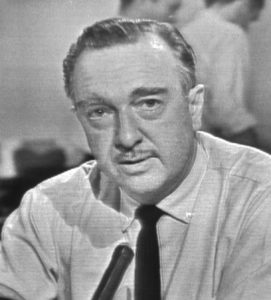
Walter Cronkite announcing the death of President Kennedy on November 22, 1963
There are numerous theories, almost too numerous to count, alleging conspiracy in ways so implausible that no intelligent mystery analyst should be led astray by them. The unfortunate term “conspiracy theory,” spoken with a sneer, has largely been born in our popular culture because of such foolishness.
No, agents of the Secret Service, sworn as their reason-for-being to protect the President, did not play large, small, inadvertent, or any other kind of role in setting up JKF for assassination. Nor is it any more believable that the FBI, as an organization, would have anything to do with the murder of their President. (Yes, Hoover had a deeply flawed character, but caution, some say cowardice, was among those flaws, he wouldn’t have dared.) Overall, there was no vast, multi-agency conspiracy, in which scores of persons with the Dallas police, the Federal Bureau, and every other entity under the sun all conspired to betray their country, and successfully kept quiet about it for half a century. (Walter Cronkite sincerely doubted the existence of any large-scale conspiracy, largely because his life experience had taught him that widely-held secrets are incredibly hard to keep.)
Simply put, most of the conspiracy thinking and writing since 1963, a good ninety-five per cent of it, appears to us as utterly bankrupt as to both facts–the premises–and the logic derived from them.
For reasons too complex to write about here, we’ve accepted the basics of the ballistic and core forensic evidence as honest, rather than staged. To give but one example, watch the NOVA documentary on the ballistics and other science surrounding the famed “single bullet theory.” The conclusion of the experts (who seem unbiased to us, with no hidden agenda to push) is that not only is the theory possible, but indeed the single bullet theory is the ONLY explanation that fits the facts and science to a tee. We find no fault with that conclusion.
Does all the deflating of “conspiracy theories” in this case, including the hard-hitting statements to be found later in the next section, mean we find no evidence at all even suggesting potential conspiracy? Not necessarily.
There are, at least, some anomalies and troubling loose ends in the whole affair. The question for you to answer is: are there more unanswered questions and unexplained events on the landscape than a complex and chaotic event like the assassination of a head of state would normally produce? That’s your call to make.
For those who think the Warren Report captured the whole truth from the beginning, with no stone left unturned, some challenging items:
- Lee Harvey Oswald supposedly showed interest in the emerging, technical side of espionage, such as “microdots,” understood only by intelligence insiders at that point in history. Did Oswald have more of an intelligence role than the official record indicates?
- George de Mohrenschildt, the enigmatic and psychologically troubled aristocrat, and a quite unlikely friend of Lee Oswald in Dallas after his return from Russia. It seems probable that de Mohrenschildt did some debriefing work for the CIA, despite official disclaimers. An interesting fact is that de Mohrenschildt shot himself through the mouth within hours after being told an HSCA investigator, Gaeton Fonzi, was in town to talk to him. Although he was a steadily sinking psychiatric case, survivor of numerous other suicide attempts, Fonzi and others are not out of bounds to find the coincidence suggestive.
- Oswald had at least bumped shoulders with David Ferrie, in their youth as Civil Air Patrol members in New Orleans. A famous photo from the era shows them both. Did their relationship continue, as some sightings claim, and was Ferrie’s sudden death, at a time when New Orleans D.A. Jim Garrison scrutinized him, truly of natural causes?
- David Atlee Phillips figured in enough CIA black ops to darken the daytime sky, and “lied in his sleep” according to his wife. One anti-Castro activist claims to have seen Oswald and “Bishop” together in 1963. Did Phillips know anything of real significance about the assassination that he kept to himself?
- Oswald in Mexico City, at the Cuban and Russian embassies, supposedly arranging the paperwork to be on his way to join and impress Fidel Castro. Documentation, real or forged, exists to show Oswald at bus stations on his way south, and the like. But the trip dissolves into controversy–why was Sylvia Duran of the Cuban Embassy manhandled by Mexican police, allegedly at the behest of the CIA (Phillips was said to be involved in Cuba operations in Mexico City, CIA station at the time), why did a “photograph of Oswald” from those days turn out to be someone else, and why did CIA functionaries always seem uncomfortable with the whole line of questioning, for years afterward? It’s one of the more confusing passages in Oswald studies.
- Frank Sturgis of the CIA (of Watergate break-in fame the next decade) allegedly involved Marita Lorenz in a two-car caravan to Dallas, late November of ’63, full of thugs and an arsenal of weapons. Lorenz says she begged off the assignment, whatever exactly it was, and separated from the group but that Sturgis later bragged to her expressly that they’d killed the President. Obviously explosive testimony, if at all plausible.
- Howard Hunt, also known from the following decade and the Watergate scandal among other dirty tricks. It was a magazine article, and resulting civil litigation, alleging that Hunt (active CIA) was in Dallas and involved in JFK’s demise that gave rise to attorney Mark Lane’s chronicle “Plausible Denial,” mentioned earlier. Hunt sued for defamation, but Lane and his witnesses persuaded a jury to find against him. For Lane, the jury had found that Hunt was guilty of the allegations and that the CIA had in fact murdered the President! But only one juror was thus outspoken–the rest found much more specifically that the criteria for defamation, narrow in a First Amendment country, were not met as per the judge’s instructions….Lane was involved in a fascinating, important case here. (But Lane relentlessly cherry-picks his facts and examples, acting as a sort of photographic negative of his opposition by ignoring evidence that doesn’t suit him, but loudly trumpeting those limited facts that make his pre-conceived points.)
- Lee Harvey Oswald was in Dallas police custody for nearly forty-eight hours before his own shot to the gut from Jack Ruby, and numerous law enforcement personnel had access to him. But very thin record of any interviews exist, certainly no recordings, although that was much less common in those days. Just what did he say to whom, and why were essentially no contemporaneous records kept?
- Robert Blakey, lead Counsel for The House Select Committee on Assassinations, told investigator Gaeton Fonzi early on that the new probe would undoubtedly leave some “loose ends,” that it’s not always possible to wrap everything into a tidy package with square corners. Fonzi was scornful of a cop-out, as he saw it, but experience with complex cases should teach us that Blakey was absolutely right. A case like the assassination and its frenetic aftermath, by its very nature, will leave a few jagged corners and loose ends. Even professionals–from law enforcement and other specialties–make mistakes under pressure, and especially in unprecedented circumstances. No one in Dallas was expecting to host the most dramatic crime since Lincoln was shot, and everyone was caught in a state of shock. Most professionals did their best under the circumstances. So it’s for every mystery analyst to decide: are there more loose and puzzling facts, more surprising unnatural deaths, more troubling bits of evidence in this case than there ought to be, if the explanations are innocent? Remember, hundreds of books chase those questions.
THE CASE AGAINST CONSPIRACY
CAN OVER SIX HUNDRED BOOKS BE WRONG (EVEN IF THEY ALL HAVE DIFFERENT THEORIES)?
The Crime of the Century: The Kennedy Assassination from a Historian’s Perspective
Of the hundreds upon hundreds of JFK Assassination books, the overwhelming majority of them posit some sort of well-planned conspiracy to his death, even though the theories are all over the place, and many are mutually exclusive. But even substantial, responsible-seeming figures will speak of conspiracy as a fact, with only the details remaining shrouded. In The Crime of the Century: The Kennedy Assassination from a Historian’s Perspective (1982), the University of Tennessee press lends credibility to a Southeastern Louisiana University professor’s book. “One inescapable conclusion gathered from a careful scrutiny of (the) evidence is that President Kennedy was assassinated because of a conspiracy,” asserts Michael L. Kurtz. The reader then sits back, waiting to be impressed by the definitive interpretation from a professional, but the knowledgeable reader could easily be disappointed. The author accepts most official government testimony (Warren, HSCA, FBI, even CIA, etc.) lock, stock, and barrel while coming up with other alternative evidence no one has ever heard of before. Dr. Kurtz also offers a few second and third-hand anecdotes–e.g., the post-assassination call Clare Boothe Luce received from a Cuban exile claiming that Oswald had returned from Mexico City flush with money–that he would never accept as proof of anything (one would hope) in a student paper in his class, and uses these brittle scraps as strong pillars for his belief in conspiracy as a virtual certainty.
Perhaps Kurtz’s theory is intriguing: four shots, three shooters, and the fatal wound on the right side of Kennedy’s head represents Both entrance and exit wounds, as Oswald’s shot and the grassy knoll sniper’s contribution went through the same spaces, separated by fractions of a second! In fairness, Kurtz did not have the benefit in 1982 of knowing that the “acoustic evidence” of four shots being fired would be discredited, and that no one has proof to this day of more than three shots. In a way, that’s a common pattern, and we’ve learned that the most thrilling theories about November 22 are not at all like fine wine. Time is not kind to them.
Overall, the most striking thing about the prominent believers of broad conspiracies to kill JFK is the tall, bold mountains of conjecture they construct from such small molehills of fact. And most of the “facts” about supposed Warren Commission lies, or altered evidence, or hidden witnesses quickly recede when chased down, like bugs that disappear into the woodwork when the bright lights are on. They often waste our time, these extreme believers in conspiracy, with stunning, breathtaking witnesses, who spin the grandest, most amazing yarns. Impressive witnesses, except that they spout–if we may use plain language–complete and utter poppycock. In the previous section we tried to be polite about the “revelations” of one Marita Lorenz (apparently a genuine, early lover of Fidel Castro and possibly the mother of his child, incidentally). She was the one who found herself in a car full of guns and determined men, bound for Dallas, just days before the assassination. She made the mistake of placing one Lee Harvey Oswald on that journey as well, Lee who was checked in at work, at a certain book depository, those very days. Even without such glaring contradictions, investigative bodies soon despaired of believing any word that fell from her lips. If she’s credible, they concluded, so’s the notion that Dumbo’s ears provided sufficient lift to produce the world’s first flying elephant. By the way, she supposedly became uncomfortable and slipped away from the Dallas mission, conveniently in her story taking herself out of complicity. Yet later (CIA-trained) Frank Sturgis tells her–someone who didn’t have the stomach to stick around–that they had great fun killing their head of state. The CIA schools its people in the most basic principle of them all, you impart information on a Need To Know basis only. One would assume that a domestic operation to murder a sitting President would embrace the tightest verbal security, among other safeguards, of any CIA operation in history. We could go on and on with Lorenz’s contradictions, but there’s really no need.
The justification for wasting a whole paragraph, and your time and ours, on Marita Lorenz rises from the overall point: so many of the eye-popping conspiracy stories undulate seductively like mirages in the desert, striking and appealing from a distance. When you walk right up to them for a close look, that’s when you realize you’ve been had. More than one story along those lines–two guys in a car with rifles and yep they really killed Kennedy–has emerged over the years, but not one has ever achieved the credibility of a $3 bill with a picture of Dick Nixon’s nose on the front.
Then there are the stories that do manage some credibility, but they don’t have much sound and fury, and seem to signify nothing. The previously mentioned example of that category, the Silvia Odio incident, serves nicely. Odio had her own mental health challenges from severe stress in that passage of her life, but researchers give her the benefit of the doubt. Oswald was supposedly at her door one night some weeks before the assassination with anti-Castro radicals. But even if that was Oswald, not a certainty, the remarkable thing is the use of the incident by strong conspiracy believers to make their point. When if anything it further fills in the brush strokes on the Lee Oswald of 1963–described by those Cubans (later to Odio in private conversation) as odd, unpredictable, a little unnerving to have around. They intimate that this guy may be capable of most anything. We fail to see how this account of events, even if accurate, in any way undermines the dangerous, violent-maverick image of Oswald and his ultimate actions.
But the true-and-tried proponents of conspiracy just don’t see it that way. Gaeton Fonzi (who died in 2012 and can’t join a spirited debate on the matter, regrettably) concludes that the Odio incident “absolutely cries conspiracy,” and that in fact he has “no hesitation in declaring the Kennedy assassination a conspiracy based strictly on Silvia Odio’s consistently credible testimony.” Seriously? Yes, “the issue of conspiracy is not contestable,” he opines in the final pages of “The Last Investigation.” “It never was.” Among the reasons that conspiracy should be as plain as the nose on anyone’s face: “a preponderance of evidence that Lee Oswald had a an association…undoubtedly with the Central Intelligence Agency.” Preponderant evidence, or actually…well…none–nothing clear and unequivocal after a half century of searching and speculation.
In the end there’s the common sense path our minds should follow: Oswald’s short life and history, from age 17 to 24, virtually cried out for attention from government investigators. His affection for Communism even as a teen-aged Marine, the defection to the USSR, the Russian wife, the open radical activity, the dust-up on New Orleans streets with counter-radicals, the appearance on local TV representing Marx and Lenin, the generally threatening and defiant countenance. If the CIA, or FBI, or both had kept tabs on him a bit more than they wished to admit after the disaster of the assassination, should that really be so surprising? But to stretch from government awareness of who he was to a cozy working relationship, and stretch from there to collaboration in murdering the President of the United States is simply breathtaking.
Fonzi’s leg work was clearly tireless, his writing abilities were excellent, almost a model for the hard-charging, high-productivity journalist. He certainly never needed a course in Remedial Journalism, per se. But he certainly would have benefited from a course in Remedial Thought. For Fonzi to leap from the slender facts that he cites to his stunning conclusions leaves a good critical thinker agape with the sense of having seen Evel Knievel fly clear across the Grand Canyon on his motorcycle.
Yes, the companion trait to all the great flights of logic is the certitude, for after all conspiracy is simply “not contestable.” Only the pesky details remain unanswered, “the names of the individuals who held the weapons or synchronized the shooting.” But those individuals haven’t been identified in that half century of searching and likely never will be, not because of a silky smooth cover-up to a conspiracy, but because it’s quite unlikely they exist at all.
WOULD SMART, WORLDLY PEOPLE PLAN A DEALEY PLAZA, DALLAS, ASSASSINATION?
Let’s leave the issue of the missing evidence of conspiracy to walk down a different logical road. We intend to make the case that 1) a full-blown assassination plan by significant parties would have been irrational, illogical, utterly unlikely, and 2) even if you stretch you mind, rubber-band style, to embrace formal assassination planning, the Dealey Plaza option would have been the riskiest, and therefore the last, idea on the list. Simply put, it makes less than zero sense that any group with any collective brains would have cooked up the November 22nd shooting, as we know it, as a means to their ends.
1) In an earlier section we enumerate some of the entities who might have fervently wished for a quick change of administration in Washington. Kennedy may have may stirred up more than the average consternation among powerful opposition groups, but Presidents always have bitter enemies, and those groups almost never mount assassinations, or even coups. The Lincoln exception was on the tail of all-out civil war, and his assassins did not consider him their legitimately elected leader but rather a “tyrant,” as Booth bellowed in Latin. (A half-baked coup aimed at FDR’s administration went nowhere before exposure, even with top generals involved, and the plan was never to put a bullet in the old man, just move power over to a more martial footing). It’s become part of our political culture over 200 years to accept the elected administration until the next election cycle and remove them at the ballot box, which leads to a rather obvious line of reasoning.
Kennedy had won by only a hair’s breadth in popular vote in 1960, faced another election in 1964, and while charismatic by some estimations he was highly vulnerable. Hindsight affords us a look at Barry Goldwater’s clumsy campaign and landslide loss to LBJ, but that November when 1964 lay just ahead it looked tight, and Kennedy’s people were politically anxious. And that was with the Camelot myth fairly intact, and the Kennedy brothers’ many picadillos mostly kept out of the press. So, if the cabal of conspirators possessed such range and power that they could muster the most brazen and complex assassination of the modern era, and manipulate knowledge and investigations about the case for decades afterward, why would they not simply make sure, for example, that the “gentleman’s agreement” that kept public men’s salacious affairs private was abandoned in 1963 and ’64, instead of surviving until the 1980’s and Gary Hart’s fall from grace? Kennedy’s detractors did include powerful right-wing connected media enterprises, the Luce publications for example. The CIA was capable of digging up (or manufacturing) dirt on anybody, and over at the FBI J.Edgar Hoover, no friend of the Kennedys, already had a ton of filth on JFK in his files.
Could the Camelot halo, and the administration, have survived public knowledge that JFK entertained prostitutes (of all races) in the White House every time Jackie left town? Would it be okay that he had Marilyn Monroe’s emotions so tied in knots, from their affair, that she had waited for the day he would divorce Jackie and bring her to live in the White House, and that the Kennedys may have suppressed and manipulated the facts concerning her death in 1962, to avoid scrutiny? Would the public tolerate knowing that JFK’s many illicit lovers in his life had included suspected spies, or that his marriage to Jackie was not his first, an early indiscretion having been cleaned up by old Joe Kennedy? And these are just some of the moral failings that JFK was heir to, while surely a Reputation Hit Squad could have planted dozens of stories as well, whether true of false, that cast a dim political light on JFK. Kennedy’s margin in 1960, perhaps one out of a hundred votes, didn’t leave much room for scandal and loss of public image, with JFK remaining electable. So, why run all the risks inherent in a domestic assassination when simple murder of his political life should be quite manageable, especially when Kennedy has given you the ammunition with his own behavior?
(It might be instructive for a moment to consider the case of James Earl Carter, elected President exactly 16 years after golden-boy Kennedy. Now, there was a guy who was threatening to some of the most powerful established interests. Big oil, with his windfall profits tax ideas, and strong alternative energy promotion. War profiteers, unhappy with his insistence on test-ban treaties and detente in general. Others from the political right, dismayed at all his government give-a-way programs. Why let a guy and an administration like that ruin the fine parade, just because he had an engaging smile and a history of designing nuclear submarines with Admiral Rickover? By one means or other, we need to get rid of this guy, the military and financial powers might have concluded, as early as 1977 or 1978. Clean as he was, he couldn’t be easily derailed by scandal, making him a candidate for the next elaborately planned assassination. Except that he was allowed to live–many more decades as it turns out–and be beaten at the polls by Reagan, the Great Communicator. So the reminder, it’s generally over the top to assume the assassination of our Presidents by otherwise sane and responsible people.)
2) But let’s really stretch a point and suppose, in the great exception of our history, that a sitting President could not be tolerated in office even a month longer and that he quite simply ‘had to be got.’ Again, we should follow the logic out to the fullest: if agencies and individuals with real “juice” and worldwide reach were complicit in plans to eliminate Kennedy, the venues and possibilities were numerous. Why not have him poisoned in a foreign location (he traveled a lot, domestic and foreign), and cover the tracks but drop some breadcrumbs that seemed to lead back to an unfriendly government? Surely a better way to rub out JKF and implicate the enemy than attempting to frame Oswald, who was never really taken seriously as anything, even as a Communist. And what about all the subtle-kill gadgets that the CIA had developed even by the early sixties, a pin-prick to the hand that might not even be noticed by a busy President shaking hands right and left, but would soon cause certain death? In the 1970’s the CIA entertained Congressional Committees looking into its activities with a show-and-tell of myriad methods and technologies of sudden death. Something, somewhere could have been used on President Kennedy in a manner both sure and relatively subtle, not the dicey, uncontrollable commotion in Dallas. In Dealey Plaza any one of several factors could have rendered the head shot mute, from someone spotting the sniper early on to Jackie pulling JFK into her lap at the first shot to quicker Secret Service reaction to a bullet placement off just three inches to the right. Even a domestic assassination by bullet would have been a surer thing with Kennedy at a podium speaking, a stationery target, and he spoke a lot.
Seriously, place yourself in a group looking at options to kill JFK, and someone comes up with the bright idea of a hit as the President passes through downtown Dallas, and Dealey Plaza with its wonderful “triangulation” possibilities. (Forget for a moment that the decision on where the President would speak to his lunch crowd was made, relatively last-minute, through internal Texas political wrangling, and thus conspirators would have had little time to scope out the Dealey Plaza scenarios along that route.) So someone in the group says yes, perhaps multiple perches for snipers, but also multiple perches for law-enforcement observers, there’s even a Sheriff’s Office and jail with high windows looking down on events. People, just like our snipers, will be absolutely everywhere around that place. Too damned unpredictable. And a moving target left to right, from behind that wooden fence, and those edgy Secret Service guys might speed up the Presidential limo, or slow down, God only knows when. Even the best snipers in the world, like our guys, could miss if they’re squeezing a shot just as someone speeds up or the President rotates way around to wave to someone he recognizes. A shot could easily hit the popular First Lady, for Heaven sakes! And there’ll be hell to pay if we shoot and miss, kind of like swatting at a hornet but leaving him alive. If Kennedy is a pain in the ass now, just imagine….
It’s not difficult to see that the Dealey Plaza, let’s-frame-that-sadsack-Oswald option might be the most creative, but also the most far-fetched scenario that could be advanced. How do you time the President’s passage down Elm Street–remember Presidential trips run notoriously off-time–just as Oswald’s co-workers all have lunch downstairs, thus affording him private minutes in the real (or staged) sniper’s nest at precisely the right time? For that matter, how can you be sure that Oswald’s boss won’t have other plans for him that day, working in tandem with someone else on another project? We could go on. The variables that have to fall into place are countless, the Japanese had an easier task planning Pearl Harbor. It just doesn’t take long to see: even if powerful and duplicitous conspirators are out to get Kennedy, the Dealey Plaza option would be pretty much at the bottom of the list.
WHAT ABOUT THE ALMOST ENDLESS LIST OF MISSING OR DISPUTED EVIDENCE, AND CONTRADICTORY TESTIMONY, IF OSWALD AND RUBY WERE JUST FLUKES AND LONE NUTS?
After 600, if not 700 or 800–who can really keep count?–books on the assassination, the waters are certainly muddy, and the air still full of unanswered or seemingly unanswered questions.
We could engage in debate on literally a thousand points of minutiae, but we leave it to the individual researcher to delve into the thousands upon thousands of pages of documentation and decide if, at the end of the day, significant evidence has gone missing or been altered. As the Mind Over Mystery site we take the Analytical view. Our forté is how to evaluate the Full Context of a mystery, how to finally decide which way the weight of evidence and logic fall.
In the immediate hours and days after JFK’s murder, shock, yes utter shock and dismay was the dominant emotion, not historical suspicion. That is to say, when one law enforcement agency pulled rank on another and said, We’ll take those photos–autopsy notes–bullet fragments, whatever, our jurisdiction now….this had much to do with professional shock and the oldest instincts of all, covering one’s butt and looking good to one’s boss. At the FBI, Hoover was notorious as the most punitive man alive if you did anything as an agent, anything at all, that embarrassed the Bureau. That’s surely why the ‘Hosty Note’ was destroyed: It seems agent James Hosty, keeping some tabs on Oswald, had talked to Marina Oswald a time or two while Lee was at work. Lee was livid, stormed down to local FBI headquarters, and apparently left a somewhat incendiary note–to the effect, if you don’t stop bugging my wife I’ll blow this damned place up. Remember, Oswald was Oswald. In the short run, Hosty’s supervisor hinted that ripping and flushing that note would be best, and it was thus destroyed, and admitted to much later. Why the hasty destruction of evidence? Because guys making their living at the FBI feared Hoover more than anyone fears the Devil. Even without the note, Hoover internally was quite punitive about the Kennedy case, demoting agents like crazy who somehow, through some prescience, should have anticipated the assassination and made the Bureau seem more on the ball in tracking Oswald. J.Edgar expected everyone else’s hindsight to be twenty-twenty. No, none of this is fair or rational, but Hoover’s fearsome reputation is legend. You must Never, Ever embarrass My FBI, dammit!
Examples like this illustrate the reality: in the immediate aftermath, mortified agents of the FBI or Secret Service or Dallas Police Department–whatever agency–were struggling with both the unprecedented event, and the professional and psychological pressures that implies. Agencies jockeyed for position, or to save face, or received orders from the deceased President’s family (which included the sitting Attorney General, don’t forget), or the newly sworn President, that this should happen, or this procedure be followed. The sensitivities of the widow and family of JFK that the bloody pulp remaining of his head and brains not be kept around as a spectacle was in the mix, as were a dozen other considerations. What law enforcement and medical personal were not thinking much about was: just how does this look? and could an author five years from now make us appear to be conspirators because we gave this piece of evidence over to that agency, and let these notes go astray? No one anticipated how the events of Dallas, November 1963 would turn into the most suspiciously scrutinized event of all time, or else individuals might have covered their butts in different ways, anticipating the questions of history. But at the time, 600 future conspiracy books were hard to imagine.
This is not meant to imply that each and every concern raised by researchers fades as insignificant. The initial doctor who made some autopsy notes, but supposedly destroyed them. Why? Any one with the I.Q. to go to medical school should realize how stupid that would look thereafter. There are a number of post-assassination questions of which a reasonable person could ask, what the heck was up with that? We mention several of those incidents, or questions, in the previous section.
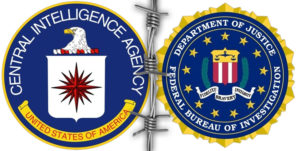 Nor do we imply that key agencies, such as the FBI and CIA, always acted appropriately with the nation’s interest in mind as the investigations began. We’ve already discussed how the tone set by Hoover turned the FBI of the era into a very closed, self-serving culture, and assassination researchers sometimes come across evidence handled by the Bureau and wonder if that handling was slanted not with grand conspiracy in mind, but simply the FBI straining to look good. The public’s current and historic Right to Know was low on Hoover’s list of priorities. And the culture of the CIA makes the FBI look totally transparent and forthcoming by comparison. Many JFK assassination books soon degenerate into speculation, from the outside, about what went on inside the CIA, before November of 1963 and after. It makes for a hard call. Has the CIA been so secretive, and downright dishonest with investigators over JFK-related matters because there was something substantial to hide, or because the culture itself is one of disinformation, from dawn till dusk? To keep perspective, it’s good to remember, just for example, that the one time that a CIA insider, Director Bill Colby, began to even melt around the edges into honesty with Congressional Committees–his simple constitutional duty–he was soon replaced by President Ford with someone better with secrets, G.H.W. Bush. And as late as 2014, Senator Diane Feinstein, head of CIA Senate oversight, became incensed with the revelation that the agency was essentially spying on her and her staff, attempting to stay one step ahead of any annoying supervision. The inward-turning culture of disinformation has been a constant at the CIA, making it hard to separate a rogue, secretive, barely-supervised public function from any specific misbehavior in the whole JFK-Oswald affair.
Nor do we imply that key agencies, such as the FBI and CIA, always acted appropriately with the nation’s interest in mind as the investigations began. We’ve already discussed how the tone set by Hoover turned the FBI of the era into a very closed, self-serving culture, and assassination researchers sometimes come across evidence handled by the Bureau and wonder if that handling was slanted not with grand conspiracy in mind, but simply the FBI straining to look good. The public’s current and historic Right to Know was low on Hoover’s list of priorities. And the culture of the CIA makes the FBI look totally transparent and forthcoming by comparison. Many JFK assassination books soon degenerate into speculation, from the outside, about what went on inside the CIA, before November of 1963 and after. It makes for a hard call. Has the CIA been so secretive, and downright dishonest with investigators over JFK-related matters because there was something substantial to hide, or because the culture itself is one of disinformation, from dawn till dusk? To keep perspective, it’s good to remember, just for example, that the one time that a CIA insider, Director Bill Colby, began to even melt around the edges into honesty with Congressional Committees–his simple constitutional duty–he was soon replaced by President Ford with someone better with secrets, G.H.W. Bush. And as late as 2014, Senator Diane Feinstein, head of CIA Senate oversight, became incensed with the revelation that the agency was essentially spying on her and her staff, attempting to stay one step ahead of any annoying supervision. The inward-turning culture of disinformation has been a constant at the CIA, making it hard to separate a rogue, secretive, barely-supervised public function from any specific misbehavior in the whole JFK-Oswald affair.
Overall, though, life is life and people are people, fallible and incompetent at times especially in emergencies, but not necessarily part of any top-heavy, elaborate plan involving wide-spread collusion. They’re just fumbling through unsettling situations as best they can. You be the mystery analyst, you study the physical evidence and testimony for a couple of months, and see if you find any “smoking guns.” For us, the burden of proof should be on those who allege vast, complex plans and cover-ups.
IF THE CASE FOR CONSPIRACY IS SHAKY TO NON-EXISTANT, AND THE STORY DEVOLVES BACK TO A COUPLE OF ODDBALLS AND RANDOM, TRAGIC EVENTS, WHY DO ALL THOSE BOOKS CLAIM THE OPPOSITE?
Why, indeed?
Suppose you’ve rushed to the Denver airport to catch your three-plus hour flight back to New York, but your flight is slightly delayed so you browse a bit in the bookstore. You like to read “non-fiction,” and enjoy true crime and government intrigue and the like, so the Kennedy assassination has always interested you. Two new paperbacks on the shelves address the topic and you read the covers. One intends to show you Jack Ruby more close up and personal that you’ve ever seen him, on the path to explaining he, just like Oswald, was a nut who always acted alone, and certainly did that November. A new book with really nothing all that new and exciting, even if it may have interesting moments. The other claims to reveal the ultimate confession of a major mobster, who’s going to implicate CIA operatives who cooperated with his crowd in everything from bringing heavy drugs into the slums of L.A., with profits going to finance anti-Communists in Central America (all of which may have some factual basis), to earlier collaboration on plans to assassinate Fidel Castro (which definitely has a factual basis), to collaboration, finally, in designing a plot to kill the President of the United States. You leaf through both books a minute or two. In the book about Ruby, you’ll be reading about his little penny-ante business ventures and checkered history with nightclubs, his not infrequent fits of temper, his almost pathological love of his dogs, who were his real family. In the other book, you open to a page where the honesty, or corruptibility, of every narcotics cop on the West Coast seems to be at play, and obviously all this leads someplace even bigger and more scandalous. Which book do you drop a few dollars on for airplane reading? Kind of a no-brainer, isn’t it? Which book will generate greater sales and royalties for its author? If you’re a “follow the money” type of author, you realize the conspiracy path, for writers, has all the wind in its sails. As new “evidence” is uncovered or new “witnesses” finally come forward, you can always refine your theory and publish new books, generating new waves of income.
That’s the problem with writing No-Conspiracy Books. Once you’ve explored Oswald’s and Ruby’s personalities, and basic logic leading up to Oswald’s lucky chance for privacy on the sixth floor, at the right time, with a rifle in hand he’s already used in an assassination attempt (General Edwin Walker, months earlier), once you establish that in this instance anyway the Official Story is more or less the accurate one (even if governments lie like crazy much of the time), once you make that case, there’s not that much more interesting to offer. There’s no need for a hundred books to say, over and again, that lone nuts did all that, although there are perhaps a dozen such. And few bestsellers among them.
But on the conspiracy trail, there’s always a new bend in the road. If a juicy new perspective doesn’t show up some other way, there’s always the “confessions” of people who just can’t hold in the truth anymore, and have burst out to you, the author of this new exposé. For the reader there’s something fresh to cogitate on, not the same-old, same-old, Oswald was a dangerous nut. And the stage setting was kind to the writers of breathless conspiracy tales: that is, there really were lively pro and anti-Castro characters running around in the early sixties, there really was a lover shared by mobster Sam Giancana and JFK, there really was turmoil at the CIA in the wake of their horrible planning for the Bay of Pigs invasion of Cuba. Central Casting has a lot of rich characters to choose from in filling up the field of vision with interest and intrigue. Truth can be jazzier than fiction, although most of these authors blend the two, quite liberally.
And if these books offer an almost endless parade of witnesses who claim to have seen this, or heard that, it helps to know something of the context of sensational crime. Almost every truly celebrated crime has generated spontaneous confessions–from people who clearly had absolutely nothing to do with it! Such is human psychology, in a complexity we won’t tackle here. But be aware if you plan to come out of the woodwork and confess to a celebrated murder that experienced detectives will roll their eyes at you, may well not believe you even if you really did it. You’ll probably have to prove it with DNA. Nor will they readily believe that your next-door neighbor was the killer, because you finally now recall seeing this or that suspicious activity.
Not only is “eyewitness” testimony not all it’s cracked up to be, very often erroneous or misleading, but keep in mind as well the squirrelly pattern of witnesses who improve with age. In the Kennedy killing, several witnesses often cited in the vast-conspiracy books offered one level of recollection, to investigators, thirty-five minutes after the shooting, but seemed to remember more each year, or at least each interview by an author. After thirty-five years, their stories had swelled to several times their original size, like fish stories grown over time. If you think that legitimate memory doesn’t work this way, doesn’t improve as the years go by, you’re quite right.
Massachusetts’ most notorious gangster of all time, Whitey Bulger, was at large and wanted for fifteen years by the FBI. A sharp-eyed citizen in California did deliver the tip, and authorities found it credible enough to follow up on and bingo, a captured Bulger in 2012. But along those years, an FBI official says over 400 well-meaning citizens reported sightings or suspicious activity, over 400 leads were chased down. How many turned out to have any validity? Well, actually, zero…said the FBI. Finally one tip out of well over 400, in the end, was accurate. Are we understanding the pattern here, and learning a healthy skepticism about all these “revelations”?
To sum up….
“You’re not right,” our favorite billionaire Warren Buffett says, “because people agree with you. You’re right when your facts and reasoning are right.” We think that way at Mind Over Mystery–researching and thinking soundly is not a popularity contest. The number of books that tout conspiracy may vastly eclipse the number of books that posit a sole assassin, but those numbers mean little and we’ve discussed the inherent popularity, above, of the more fanciful stories. Likewise, we constantly hear about polls that give conspiracy beliefs a wide margin over sole-shooter among the general public. With all those books about, with the word “conspiracy” used by the House Select Committee on Assassinations based on erroneous evidence (it’s hard to unring a bell, most folks don’t know the Committee goofed, and newspaper retractions on any article never print as prominently as the original story), and with Oliver Stone’s “JFK” comprising all some folks know of the issue, those numbers are probably predictable. But again, good mystery analysis is not a popularity contest.
It’s worth mentioning that Stone’s movie is so full of misleading scenes and “facts” that Vince Bugliosi attempts to list them, and does enumerate several dozen over several pages of discussion before running out of steam, and patience. His beef with “JFK“ is that the entertaining fiction masquerades as based-on-fact, when it employs some, but very little, solidly factual material. We at M.O.M. saw the film several times, first before reviewing anything about Dallas ’63 and later after brushing up significantly on the historical record. It seems like a very different film once you realize that’s its well-acted, entertaining malarkey.
In the end, M.O.M. finds the Lone Nut(s) case much stronger, and much more logical, than any of the scores of theories involving conspiracy. But it’s important for all of us to keep our minds open, and be willing to change opinion if and when new revelations warrant it. We promise to conduct a review of the JFK files every two to three years, and adjust our views accordingly.
THE POSSIBLE AND THE PLAUSIBLE
THINK CONTEXT, THINK SCENARIO, THINK PLAUSIBILITY
Somewhat understandably, believers in powerful, unseen forces behind JFK’s shooting ask just how plausible it is that L.H. Oswald would end up with a seemingly tailor-made assassin’s nest perched nicely above the motorcade, available just when Oswald needed it. How could such a supposed nobody muster, by himself, such customized circumstances from which to shoot the President? True, think of every multi-storied building you’ve ever been familiar with. How many of them are full of vast empty spaces (except for stacks and stacks of books), and inhabited by a very thin crew of employees, an average of only a couple a floor, who nonetheless leave certain floors deserted for long stretches as they work elsewhere, or take breaks or lunch? That’s really a lightly staffed warehouse scenario, except in this case a building with conventional windows, overlooking the street like office windows, has been converted to warehouse use. A sniper doesn’t have to commandeer an office to set up at a window, a sniper just needs a few moments when no one else has business on that wing of that floor. What are the odds that Lee Harvey would land a job in such a structure, on a route that occasionally saw dignitaries drive underneath in their limousines? Admittedly not all that high. Yet there was no hint of conspiracy to his being located there, just the coincidence of where his job searches had landed him.
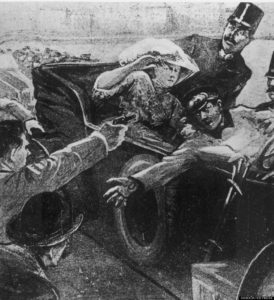
An artist’s rendition shows the assassination of Archduke Franz Ferdinand of Austria-Hungary and his wife, Czech Countess Sophie Chotek, during their visit to Sarajevo, Bosnia, on June 28, 1914. The assassin, Serbian nationalist Gavrilo Princip, left, of the group Black Hand, was captured. The incident precipitated World War I. (AP Photo)
And coincidences come in clusters, or concentric circles, sub-coincidences if you will. What if Princip had drowned his sorrows in a pint, and could no longer shoot straight, by the time the Archduke passed his way the second time? What if his fiery, outspoken political feelings had triggered a bar-brawl or street-brawl, and someone had knocked him senseless? History will turn around the narrow curves of such dimes.Skeptical? We sympathize, but keep in mind, coincidence is precisely what creates many an assassination or other history-rocking event–someone ends up with the right proximity, at precisely the right time. A thumbnail review of the genesis of World War I: there was a failed attempt that morning in 1914–an exploding device that exploded too far away from the target to get the job done–on the life of Archduke Ferdinand as he motored through Sarajevo. A later route was changed slightly but the chauffeur was not informed; he took a mistaken right turn onto the street where failed assassin Gavrilo Princip was now loitering. The car stalls, yes, stalls right in front of Princip who draws a weapon and makes good use of his second chance. He blows away the Archduke and his spouse, and the rest is world history that might have unfolded quite differently. (The nasty War cranking up a year or two later, perhaps, or even no World War I, as we know it, at all? Hard to say, because History does not clearly outline Her road not taken for us.) Although Princip had his Yugoslavian-nationalist collaborators, the consensus of historians holds that no one conspired to stall the vehicle in that spot on that street, no one colluded to give an assassin another go at the target. History often turns on the odd coincidence, and that one was a doozy, for sure.
As far as Oswald, a well documented set of coincidences, and they can fairly and only be called that, placed Lee in the job in the TSBD–Texas School Book Depository–in the fall of 1963, hoping to stay employed and win back his family. (Had he ended up working, let’s say, at a photo shop as he had before you would never have heard his name, and JFK would have served four, and probably eight years in the White House.) Lee had a rare, assassin’s twisted psyche and a few days notice that the President would be not only coming through his town, but waving to crowds in a route that passed just under his building. To someone with his assassin’s urges the pull to smuggle his rifle in to work must have been irresistible. The results are emblazoned on our history, and our national psyche.
GRAND THEORIES, GRAND SCENARIOS
Many theories about extraordinary events, such as JKF’s demise, are born from lively, expansive thoughts, but without grounding in context: in other words, precisely what would this look like in practice? Would the elements of the theory be technically possible, and if so, would they be plausible?
In the last section we offered the example of assassination planners–a serious and powerful group determined that the job must get done–deciding how best to end Kennedy’s life. The downtown Dallas motorcade, with its passage under tall buildings and by multiple vantage points, at first glance looks like an assassination planner’s paradise. Just get the job done, and no one will ever be quite sure who, from where, how exactly, other than evidence left behind by lethal bullets. Certainly the results achieved, a near-fatal shot followed by a perfect one within seconds, and the highly political look of the investigation, could plant the suspicion that a cabal of subtle people executed a plan to perfection, and thus executed a President.
Then, under the steady assault of reasoned thinking about the possibilities extended by physical evidence, and the probabilities of alternative scenarios, the notion of elaborate orchestration of multiple shooters becomes quite problematic. Or does it…might it all fall into place?
In the John McAdams book we highly recommend, “JFK Assassination Logic,” a chapter entitled “Think Scenario” encapsulates much of what we’ve learned about mystery analysis in general. The devil resides in the details and especially in the flow of the scenario. Try telling a brief story through which your theory unfolds, with real people doing real things. If every step sounds plausible, it may well be. If the story starts to sound ludicrous, sillier with every detail that must be accounted for, the theory probably collapses in real life, as well.
OSWALD, AND COLLABORATORS?
Let’s “think scenario,” and suppose that a serious group connected to the CIA had gotten in touch with Oswald and was aware how well placed he was to be a potential assassin, at least a major player, on November 22nd. In our scenario they give him encouragement to get his weapon into the TSBD and take a shot or two, but also use him as cover for having a more reliable sharpshooter in the mix, someone who will quietly disappear while the suspicion all falls on crazy Lee. They tell Oswald, you get this done, and there’ll be a 1961 Ford Falcon, light green, waiting for you outside the back doors, what appears to be a little old lady driving it, and you can calmly get in the car and be taken away from the scene. The payoff will set you and your family up for a long time.
Usually Oswald and de Mohrenschildt would chat in George’s home or whatever venue an informal gathering came together, but one night in early November, 1963, George persuaded Lee to meet him at a fashionable bar downtown. They’d been sipping their drinks on George’s tab, soft drinks for Lee, when a guy walking by the table did a double-take at seeing de Mohrenschildt, or feigned it, and reminded George of the party where they’d met, chatted. Aren’t you the man who knows the fellow fresh back from a couple of years in Russia? He was invited to sit down. “Ernie,” was how he introduced himself, said he worked a “dull job, don’t ask” for the government, and he had a shock of thick, almost unnatural blond hair, a mustache, glasses. When George pleaded a need to call it an evening twenty minutes later, Ernie persuaded Lee to stay a while, talk some more just the two of them, because he found his adventures in Russia fascinating, and admired the initiatives Lee’d taken in his life.It developed this way: Oswald was back in Dallas after his flirtation with Russian citizenship, repatriation to the U.S., and a stay in his native New Orleans. He was working a menial job, but wanted to impress Marina that could do something, support them if he needed to. He’d made a last-ditch effort to be somebody in the socialist world, to go to Cuba to help Fidel be a better Castro no doubt, but couldn’t even get a visa to travel there. Even in his fantasy world the truth penetrated in to scald his emotions at times. He’d racked up an amazing string of failures for a a guy only in his twenties, he’d been a horse’s ass at everything he’d ever tried to do, the Marines, being a Russian, or an activist fighter for freedom, or even a husband and father. Even a working stiff with a minimum-wage job. They never lasted long.
Through the Russian expatriate community in Dallas, Lee met George de Mohrenschildt that fall of 1962, and the two became unlikely “friends” by early 1963. An older, polished aristocrat from independent means, and a raw kid, bizarre and off-putting in many ways, with never a success in life, or a saved dollar, to show for his young years. No one would introduce those two thinking they would hit it off, have tons to talk about, but de Mohrenschildt actually liked the young Oswald in several ways and besides, he wished to be indirectly supportive to Marina, who depended on Lee getting his act together. True, there was another dimension to the long conversations they had, stretching into the night at times. George filled the vacuum which is aristocratic life with a few hobbies, one of which was doing a little work for the nation’s foremost intelligence agency, informally debriefing émigrés and similar world travelers on what they knew, or had observed, and reporting anything of interest to his contacts. Oswald was small and odd potatoes from the CIA’s perspective, but they were still aware of him and thought it worthwhile to hear if he had anything significant to report–he didn’t–from his stay in Minsk. De Mohrenschildt didn’t even think of it as a betrayal of their connection. The kid was over his “Russian phase,” still full of passionate political notions that would probably never amount to anything, and George was mostly a friend and advisor. He was just listening carefully for anything, by chance, that Oswald knew that the intelligence community would want to know as well.
“To be quite honest,” said Ernie with penetrating eye contact, “I’d heard of you, been wondering what the best way to meet you would be, and then here you are talking with a guy I met not long ago. What are the chances?” By the time they left the bar that night, they’d exchanged phone numbers–Ernie’s some special number that went to a makeshift office in an old building, he said. And Ernie managed to be both secretive and sharply explicit that evening, he’d wanted to meet Lee because there was important, very important work Lee could do for the cause. He wouldn’t name the cause, per se, but without saying it in so many words–it was Havana’s, and Moscow’s cause. People way up the food chain would be directing what was happening. He had authorization to enlist Lee’s help because, well, hell, how many guys that young show that much guts, learn Russian, go to the country, demonstrate they’re ready to step up. Except be very clear, this stuff would be serious. No standing around like a clown on street corners handing out some bullshit flyer to whatever clown will take it. No, if they pulled Lee into this, it would be the real thing. Obviously, one hundred per cent off the record. If anyone asks who you talked to tonight, “Nobody.” Ernie says he’ll be calling Lee, and if Lee ever needs to call him, hopefully not, he’s to leave a message on the machine as “Raúl,” same name as Fidel’s brother you know, and not say another damn word except that they need to talk.
The fourth and fifth meetings got ever more explicit. It seems the President of the United States, the bastard who tried to shoot Castro out of power and thinks he can bully Communists everywhere, that President, yes, he’s driving though the middle of town in an open limousine. Probably. Damn plans change like crazy with those dignitaries, the routes, the stops, the precise times. But can you get that gun in there–just break it down and wrap it up and say it’s something else–and get off a shot or two from a high window? You’ve said some of those floors are half deserted most of the time. All you need is a few boxes to shield you from view. A few seconds to shoot. Anyone surprises you point the gun at them and tell them to lie on the floor and count to fifty before they move. Meanwhile you’re down the back stairs, out to our car. It will have a look, our car and driver, so the authorities won’t bother it, don’t worry. And we know a way to get you across the Mexican border after the coast is clear. And quietly, from Veracruz to Cuba. They’ll treat you like a king there. Your name will be revered a hundred years from now. In time you can send for Marina and the kids if you want. Meanwhile they’ll be well cared for.Ernie did arrange to meet with Lee, little dives in downtown Dallas where the lights are low and everyone is inconspicuous anyway, four more times during their brief connection which ended, obviously, on the 22nd day of the month. He seemed to know a lot about Lee. “You have a rifle, don’t you, a Mannlicher Carcano with a scope?” he asked Lee near the end of their second conversation. Lee was too sucked in by then to be offended that someone, somehow, knew his business. He’d been flattered by Ernie from the start, and he was flattered now. Before he knew it he was boasting about his attempt on General Edwin Walker’s life, the shot from the alley behind the home. Had it not been for something that deflected the bullet a couple of inches…. Ernie acted like he knew, or that he was proud and approving if hearing it for the first team, Lee wasn’t sure what the nods meant. He just knew he was more of a somebody every time he met with this guy. The third time they met the question was point blank: would you pull the trigger again, like you did with Walker, if it meant changing history, getting rid of someone who’s attacked the rights of people in the past to choose their own government? Yes, Lee replied to the electric eye contact, but manipulation wasn’t really needed. Lee was born to change history.
On November 19th, their last rendezvous, it seemed pretty clear, JFK’s motorcade would be on it’s way to lunch at the TradeMart, down Stemmons Freeway, by way of Elm Street. And views from the high floors of the Book Depository, down Elm Street, were excellent. “Anyone else?” asked Lee. “What if I miss? Do you have some other rifles ready to go at the same time?” If Lee had more experience with reading people and faces he would have noticed an evasive flicker cross Ernie’s face, before his acted answer. “Hell, we don’t usually discuss details with the troops that don’t concern them, but you’ve earned some respect. We’ve thought about another gun, just to be sure. Not sure where we’d place it though. It’s probably just you, kid. Take your time, really, aim slowly and carefully. People will be so confused and freaked out for a while, they won’t be in a hurry to find you, won’t even be sure where the shots were from. By the time they go looking at your building, you’ll be far away, to safety.”
In fact, though, Ernie’s people had a friend who controlled a suite of offices in the Dal-Tex building, which would be mostly deserted that Friday. Most of the staff sent off-site for training, in Austin, not to return until Monday. Just a secretary, a very friendly secretary if you will, there to receive a guy in painter’s overalls and all the long “extension poles” he needs to do his job. He’d be working until about noon that day and then taking off, you might say. He would stand and shoot just a little in from the window and never be seen, barely be heard. A truly accomplished marksman, with a hi-end and highly calibrated weapon, equipped with a silencer. Lee had asked in the fourth meeting about silencing his Mannlicher, but Ernie told him not to bother. It would just attract attention to ask a gun shop to modify his gun, and it wasn’t necessary. Sound will bounce off all those buildings, all that concrete, said Ernie. More confusion that way and confusion is good. The important thing is we get you out of there. After the cops finally pull their heads out of their butts, they may have the sense to seal off downtown and question everybody… but you’ll be long gone.
Head buzzing with enough adrenaline to power the city, Lee squeezed off his shots that day. The first went God knows where, he knew he missed anyway, but worked the mechanism quickly and deliberately and aimed better the second time. He was convinced he hit something or somebody, the President or the Governor or something, as he glanced through the scope. Just as he was lining up for a last shot, a third try, he saw the President’s head blow up, as if someone had placed an explosive inside it. He was stunned for only a second, his mind quickly processed that the job was done, and he pulled the barrel of his rifle back in deliberately, almost slowly, just as an eyewitness later described. He hid the weapon elsewhere on the floor, to what purpose who knows, and bolted down the stairs. He purchased a Coke on the second floor, not really his drink but he was trying to fit in, when a cop was all of a sudden in his face, but his boss was there too, vouching for him. Working there, belonging there was golden, and the police didn’t seem to even consider that someone who worked somewhere, who had a job in the world, could also be an assassin.
When he stepped out for his ride, chaos reigned already, even on the off-streets. More police cars showing up all the time, everyone squinting at everyone else if they were looking at anything at all. That made him nervous, that and the fact he soon realized, that his ride wasn’t coming. Plan B hadn’t been discussed that much, just hang on to this address he was told, and if you need to slip down to Laredo by yourself, these folks will help you get across. Once you’re in Mexico, you’re home free. Exactly how he would do all this travel, out in the open on his own, if they started looking for the guy who’d tossed the murder-rifle in a corner, that hadn’t received much thought with everything else on his mind these last couple of days. So there he was, out on the streets with thirteen bucks in his pocket, and we know the rest.
The Dal-Tex sharpshooter meanwhile had carried his “painting supplies” down to a van with a painters logo on the side and gotten in, and the van moved away slowly, deliberately, with the driver even doing a great job of sticking his head out the window and asking a cop in a cruiser with his window down “What the hell’s happened? I hear all this commotion. What in God’s name?” “The President’s been shot, or somebody in his group. That’s what they say. We just got the call.” “Christ. Shit. God, I guess they’ll want everybody to clear these streets. Is that street open?” pointing to a side street that headed straight out of downtown. “Yeah, good as any. We just don’t know what the hell happened yet. Yeah, take that street,” and the cop moved on in a hurry, while the conspirators took the escape route the police had just invited them to take.
It had been a close call for Ernie’s group whether to get this Oswald fellow involved or not, but after they found out he had employment in a building with rare opportunities for shooting down on the street below, and it was looking like a very possible route for the President on a workday, they decided to take the chance. He wasn’t someone you’d ever ask to work for your organization, of course, not at this crazy stage of his life anyway, but a specific, controlled assignment was judged worth the risk. They didn’t need him in one sense, with professional snipers galore available. But there was his access from that building, his obvious value as a pathetic decoy. A tight decision, but they took it and engaged that night, with de Mohrenschildt making the intro.
 There were two schools of thought on what to do with this guy after the assassination attempt itself, however it went. One was to give him the Jimmy Hoffa treatment. No one would ever find so much as a tooth or a fingernail, but the mystery would keep authorities busy searching, and guessing, for years. The other was to let him get arrested, which would happen quickly, and then let him try to explain it wasn’t really his fault, he was a patsy. True, but a patsy who only knew one conspirator, in substantial disguise, who’d go underground for some years, and Oswald would look like a bigger fool every time he opened his mouth. The conspirators, hard-bitten as Nazis, opted for the Hoffa method as a first option, perhaps the surest, and cleanest. The back seat of the Falcon afforded some blankets for Oswald to duck under. The gullible guy would think the precaution was for him when it was really for them, not wanting to chance that an eyewitness would place Oswald in that vehicle leaving downtown.
There were two schools of thought on what to do with this guy after the assassination attempt itself, however it went. One was to give him the Jimmy Hoffa treatment. No one would ever find so much as a tooth or a fingernail, but the mystery would keep authorities busy searching, and guessing, for years. The other was to let him get arrested, which would happen quickly, and then let him try to explain it wasn’t really his fault, he was a patsy. True, but a patsy who only knew one conspirator, in substantial disguise, who’d go underground for some years, and Oswald would look like a bigger fool every time he opened his mouth. The conspirators, hard-bitten as Nazis, opted for the Hoffa method as a first option, perhaps the surest, and cleanest. The back seat of the Falcon afforded some blankets for Oswald to duck under. The gullible guy would think the precaution was for him when it was really for them, not wanting to chance that an eyewitness would place Oswald in that vehicle leaving downtown.
When the pair in the car–they were disguised as well, just in case–got downtown they approached by chance on one of the busiest streets, clogged by law enforcement. The driver, as she slowed to a crawl, even got a long stare from a cop she was sure she knew, although with wig and make-up her identity wasn’t easily made. At the end of one block, the next looked as dicey, and calculations of risk were made quickly. The decision–abort, and the car turned back around.
Part of the quick decision to strand Oswald resided in the pros and cons, for the option had its attractions, leaving a real, live, stuttering Oswald to consume the public’s attention for days, or years, or forever. They didn’t know the hothead would blow away the first inquisitive cop he encountered, but they weren’t much surprised. He couldn’t be doing a better job of looking crazy, and guilty, than if they’d programmed him like a robot. Yes, he could call himself a “patsy,” he’d figured that much out when his ride didn’t show, but what could he do to point the finger, really? He’d met all of one guy who was now out of the country, and Lee didn’t know any real names or even what the guy really looked like, or who the guy was connected with. That phone number had been genuine, in use for a short while, but now all traces were carefully erased. De Mohrenschildt, if ever implicated, could simply say he asked a guy he’d met only once to have a seat at a restaurant, and beyond that knew absolutely nothing (perhaps true). Lee could claim co-conspirators all he wanted, but would anyone believe him? He couldn’t offer up a shred of anything tangible. Meanwhile, Lee would remember what he’d been told about Marina and the girls: they’ll be cared for, whether the mission succeeds or not. By extension, people with that kind of power could harm them if they wanted retribution, and Lee was bright enough to figure all that. He probably wondered by now if he’d been working for the left, or the far political right. But either way–if he blames some shadowy Marxists, a group without a name or a leader or anything concrete, and he looks stupid but might anger some very powerful people. Ditto if he alleges he was hoodwinked, and pulled a trigger for the right wing. There was no way he came out looking good, no real way to take the heat off of himself. Anyone else involved had disappeared, like smoke.
He was the sacrificial lamb, and he’d do nicely butchered and served up. When Jack Ruby finished a Western Union transaction on the 24th just in time to shuffle into the county jail and impulsively kill Oswald, the conspirators were watching TV from comfortable easy chairs, at home, like everyone else. They weren’t sure what to make of the spectacle, but it didn’t really change things. The water was now just a little muddier than ever, and they were, more than ever, home free.
ANALYSIS OF AN ENGAGING STORY
Sounds, perfect, doesn’t it, a plan that gives the brains behind the conspiracy a useful tool in Oswald, and a scenario that covers what Oswald meant by the self-label of “patsy.” He realized that the others involved had successfully ducked for cover while leaving him, butt naked, walking the streets for all to see.
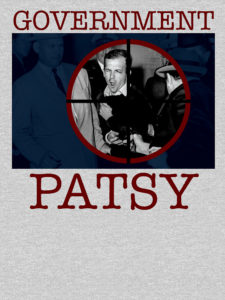 It’s even a scenario with significant elements of plausibility. If–and it’s a huge, huge if–an entity colluded with him, it would likely have been acted out much like the screenplay above. Use your high perch to shoot onto the motorcade on Elm as best you can, they tell him. Whatever happens, we’ve got your back, our network will get you out of town and to a safe haven. Oswald, with a high IQ in some ways but a child’s brain in others, would have naively believed he’d be golden after he pulled the trigger. He was delusional enough to think that Russia needed him to build Communism, that Fidel needed him in Cuba. He would think his co-conspirators treasured his virtues, not that they viewed him as an cracked, rusty hammer, ready for a last use as a tool, and then disposal.
It’s even a scenario with significant elements of plausibility. If–and it’s a huge, huge if–an entity colluded with him, it would likely have been acted out much like the screenplay above. Use your high perch to shoot onto the motorcade on Elm as best you can, they tell him. Whatever happens, we’ve got your back, our network will get you out of town and to a safe haven. Oswald, with a high IQ in some ways but a child’s brain in others, would have naively believed he’d be golden after he pulled the trigger. He was delusional enough to think that Russia needed him to build Communism, that Fidel needed him in Cuba. He would think his co-conspirators treasured his virtues, not that they viewed him as an cracked, rusty hammer, ready for a last use as a tool, and then disposal.
Unlike so many of the assassination theories, which authors advance with straight faces, that have lost all contact with reality, each nuttier than the next, this scenario achieves some basic plausibility. It passes the fundamental bar of sanity.
But although it make a smooth story, how believable are all the elements of the scenario? Do they square with the basic set-up, and all the forensic evidence as we know it?
A REVIEW OF THE EVIDENCE, AND POSSIBILITIES
Forensic, eyewitness, earwitness, and circumstantial evidence all are consistent with three shots, from above and behind the President. No credible evidence that an additional weapon beyond Oswald’s rifle was fired has ever materialized. Where are the recovered bullets from another weapon, or the wounds from those bullets, presumably fired from other angles? They simply don’t exist. We do find intriguing the idea that one or more of the shots could have been fired from essentially the same angle from a different window of the TSBD or a neighboring building, but then again, no ballistics or other evidence exists to nurture the initial intrigue.
So: the possibility that one of the few shots was actually fired by a professional sniper, working out of sight a couple of feet back from a window offering a similar angle on the motorcade, or retiring so quickly after the shot that he or she was never spotted. Yes, absolutely, that’s possible, in the sense of physical and scientific possibility. However, the factors that erode plausibility start to add up. As we know, projectiles once fired provide their own ballistic fingerprints, but no fingerprint of another weapon ever surfaced. Then there’s the question of whom firing from where, unobserved. The TSBD can essentially be eliminated because the number of employees who worked there daily circulating on all floors, less than a couple of dozen, lends itself to everyone knowing everyone else. It’s not conceivable that a stranger just waltzed in and ascended to a spot with good oversight of Elm Street, assembled a rifle, fired, and then exited the building all without anyone noticing. (We recall that Lee Oswald’s wrapped package of “curtains” brought on site the morning of November 22nd was not entirely unnoticed by coworkers, and Lee had become as familiar a sight as furniture by then.)
So, forgetting another window at the Depository, what about other buildings? The candidates are few. The Dal-Tex building, behind the TSBD relative to the back of the motorcade but not impossibly far for an expert sniper, and affording consistent angles of fire, would be the likeliest. Yet again, no explanation of whom might have gotten off the surreptitious shot, and how they would have entered a space with a promising window, set up, fired, and exited all without anyone suspecting a thing has ever been offered. The evidence–ballistic and other forensic, and eyewitness and earwitness–is simply missing. It’s farther by dozens of yards than the TSBD, although the professional marksman of our scenario might not have been bothered by that distance. In all, it’s technically possible, but you wouldn’t call it a probability.
 From the point of view of conspirators, how much of an advantage, really, is Oswald’s rifle and participation with no guarantee of results? He might rat out the plan to someone the day before, he’s unpredictable. Or the day of, perhaps he changes his odd-ball mind, or he freezes, or that twenty-two dollar rifle jams, or he’s surprised in the nest, and never squeezes a shot off, or if he does, a couple of stray bullets, fragmented, are found on pavement. He hits nothing in the limousine, but the President is shot, and other bullets are recovered. Ballistics soon reveals that a weapon other than Lee’s did the damage. What was the purpose in risking involvement with this guy, when the trace of another weapon will be left behind, anyway? Can they be sure to kill the President with some manner of exploding ordnance that will leave no clear trace, no fragments large enough to be clearly distinguished from the output of Oswald’s Carcarno? Dicey and difficult. Working Oswald into all this may offer very little cover after all….
From the point of view of conspirators, how much of an advantage, really, is Oswald’s rifle and participation with no guarantee of results? He might rat out the plan to someone the day before, he’s unpredictable. Or the day of, perhaps he changes his odd-ball mind, or he freezes, or that twenty-two dollar rifle jams, or he’s surprised in the nest, and never squeezes a shot off, or if he does, a couple of stray bullets, fragmented, are found on pavement. He hits nothing in the limousine, but the President is shot, and other bullets are recovered. Ballistics soon reveals that a weapon other than Lee’s did the damage. What was the purpose in risking involvement with this guy, when the trace of another weapon will be left behind, anyway? Can they be sure to kill the President with some manner of exploding ordnance that will leave no clear trace, no fragments large enough to be clearly distinguished from the output of Oswald’s Carcarno? Dicey and difficult. Working Oswald into all this may offer very little cover after all….
But more than any issue about ballistic evidence, or the practicality of placing snipers where you need them, there’s the underlying issue of which American entity, with the juice to pull all this off, would also have any part whatever in the assassination of a sitting President. We visit this issue one more time at the start of the following section.
A SCENARIO THAT ENDS A LIFE
On page 1490 of Vince Bugliosi’s exhaustive treatment of the November 22nd, 1963 tragedy, he enumerates the entities that have been evoked as possible conspirators in the assassination. This list of organizations, forty-four and growing, is separate and in addition, mind you, to the two hundred plus individuals whose names have received specific mention. The entities range from Germany (seriously?) to The National Aeronautics and Space Administration and the U.S. Department of Agriculture as well as the Catholic Church and the American Council of Christian Churches, why not…in addition to all of the fundamentals, like the FBI, CIA, the Secret Service, local police departments, and so on.
Most of the list deserves no discussion, and most of the rest merits less credibility than first glance might suggest. FBI agents have family, mothers and fathers and ministers from childhood. How many do you think would ever want to explain any part, however indirect, of colluding to murder the President of the United States? Not in this life or at the Pearly Gates. And the Secret Service exists to protect the President, in it’s training, fiber, heart and soul, it’s reason-for-being, enough said there. Interestingly, apparently intelligent individuals have devoted entire research careers to looking into Secret Service behavior in the assassination. Remarkable. Dallas was damned conservative in many ways, but neither the Dallas police nor local sheriff’s personnel would participate in murdering a President any more than would his bodyguards, or the FBI. (An occasional, demented local cop maybe, but by themselves they couldn’t do much, and they would lack sufficient conspirators.)
Nor were the Russians logical suspects. Kennedy was a better deal for them than most alternatives, clearly. Decades later, it emerged that Russian powerbrokers were both dismayed at Kennedy’s sudden death and worried that the history of the presumed assassin–his stint in their country–would cast unwarranted suspicion their direction, destabilizing international relations.So let’s look at traditional bad actors, like “the Mob” and hostile foreign entities. Much longer explanations are available elsewhere, but the short answers are no, no, no, and no. Yes, the Kennedy brothers had antagonized certain mobsters more than any politicians in a while, but intelligent discipline still reigned at the top of the syndicates. Organized crime had developed the wisdom to know when to poke the elephant and when to back off, to fight another day. One thing they never, ever did was declare all out war on the system ( a war they would ultimately lose and they knew it). Some years before Governor Tom Dewey (New York) had enraged the Mob, a major wise guy had declared a hit on him, but wiser criminal heads had swiftly, unceremoniously, overruled him. No taking out of major political figures, period.
Fidel Castro’s regime had motive, means, and opportunity (Cubans of all persuasions running around the U.S.), did they not? They’d been invaded by the U.S., or at least by a U.S.-led operation, and now Kennedy, while making nice publicly, was plotting assassination in Havana, which Fidel was soon aware of. What more do you need to know? In fact, Fidel also had the sophistication to see that all alternatives other than Kennedy might be worse, and the basic smarts to know that sponsoring a hit on Kennedy–however apparently well-disguised–would be handing hawkish Americans the excuse they needed to break the no-invasion promise. Getting involved would have been literally suicidal for Fidel, and his I.Q. was easily up to processing that fact.
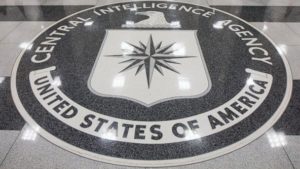 If not a foreign power, how about our own intelligence community, especially the CIA, and their horror over being split “into a thousand pieces” as Kennedy supposedly threatened after lousy CIA advice led directly to disaster at the Bay of Pigs? Actually, exactly what JFK may have said in anger, and to whom, about blowing up the agency is less clearly documented than his cogent and respectful interplay with agency officials at numerous meetings. Some rated him brighter about using their services than almost any other President, a savvy consumer of their intelligence, and it seems his relations with the CIA were on the upswing at the time of his death. But aside from all that, the agency created to serve the intelligence needs of the Chief Executive plotting to kill that executive? Anything is possible, but probable? High CIA officials even expressed discomfort at knocking off the heads of other governments, little third-world chess pieces removed from the board to serve the grand scheme. Dispatching little, no-account dictators was bad enough, it created legal and moral ulcers, but eliminating thorns in America’s side was part of the job. But now, conspiring to murder the President of the United States, that was in a whole new league, it ushered in a whole new, overwhelming reality. You be the judge. How likely do you find it that top CIA administrators would embrace such an unprecedented mission?
If not a foreign power, how about our own intelligence community, especially the CIA, and their horror over being split “into a thousand pieces” as Kennedy supposedly threatened after lousy CIA advice led directly to disaster at the Bay of Pigs? Actually, exactly what JFK may have said in anger, and to whom, about blowing up the agency is less clearly documented than his cogent and respectful interplay with agency officials at numerous meetings. Some rated him brighter about using their services than almost any other President, a savvy consumer of their intelligence, and it seems his relations with the CIA were on the upswing at the time of his death. But aside from all that, the agency created to serve the intelligence needs of the Chief Executive plotting to kill that executive? Anything is possible, but probable? High CIA officials even expressed discomfort at knocking off the heads of other governments, little third-world chess pieces removed from the board to serve the grand scheme. Dispatching little, no-account dictators was bad enough, it created legal and moral ulcers, but eliminating thorns in America’s side was part of the job. But now, conspiring to murder the President of the United States, that was in a whole new league, it ushered in a whole new, overwhelming reality. You be the judge. How likely do you find it that top CIA administrators would embrace such an unprecedented mission?
Even on the quite odd-chance that they did, would Oswald be involved, was he ever a CIA operative in any way, shape, or form? We’re reminded of the comments, thirty years downrange, of retired KGB officials who disdainfully recalled Oswald’s unorthodoxy, loud carelessness, mercurial episodes, his unsuitability in a score of different ways as a professional spy. “Whatever is given to the KGB must be done secretly, deeply, and with very strong precautions,” one KGB official emphasized to Norman Mailer in “Oswald’s Tale.” “We would never take a person who tried to commit suicide and wanted to defect. That is an abnormality.” The same can be said for the professionalism of serious roles in the CIA. After all, a good spy, by definition, is someone who knows how to operate smoothly, below the radar (no pun intended on Oswald’s radar training in the military). Oswald would have been tolerated only as long as he had specific information to dump, otherwise he was a loose cannon, to be watched from a distance. Mailer began his odyssey to know the real Oswald and real truth behind JFK’s killing leaning sharply toward conspiracy, he says, but even he concludes, more with every passing chapter, that it’s very unlikely Lee was a formal agent of any responsible sort–“Oswald would have been the last man that a leader of such a…conspiracy would have selected to be in on the action.”
If Lee was not ready for prime time–remember he was just a young, emotional amateur playing in a professional’s game–that doesn’t mean he lacked an interest in the cloak and dagger world. He would have liked to strut in a slightly mysterious cloak, we would have loved to carry a dagger. His problem was that no one ever, ever in his short life, took him nearly as seriously as he took himself.
But if all that’s true, why are “the fingerprints of the CIA all over the Oswald case,” as Senator Richard Schweiker commented during the investigative thrust of the 1970’s? During those years various congressional inquiries brought U.S. intelligence activities, and the assassinations of JFK and MLK, under close scrutiny. In one sense Schweiker was absolutely right. The every-growing CIA files on Oswald, the reports that he’d met this player or that with intelligence connections, do add up. At times, rare times, he had small streams of income unaccounted for. Inevitably some will ask: just who did he know and what information did he sell them?
Obviously the associations people maintain has always been of legitimate interest to law enforcement and other investigators. “Fingerprints” on human connections and fingerprints on a gun are worlds apart, however. Oswald did not so much “maintain associations” as stand out like a sore thumb. We’ve amply discussed why a number of agencies would maintain an Oswald file. Whether purposefully or not, he had done his best in his young life to provoke as much suspicion as any twenty-four year old we’ve ever heard of. Walking the streets nude with his hair on fire would hardly have brought him more attention. And when he wasn’t reading and brooding at home, he did get out and about to meetings of various radical groups–if he couldn’t locate trouble one way, he did another. But assuming that he was in cahoots with those who tracked him makes no more sense than accusing the psychiatric profession of setting up Reagan’s assassination to get more funding for the mentally ill. John Hinckley, Jr. was their frequent patient, and doctors were in a position to put all sorts of “suggestions” in his head. Thus the “fingerprints” of psychiatrists were all over the the 1981 shooting, were they not? And isn’t it clear that U.S. Postal Inspectors had “fingerprints” all over the acts of Ted Kaczynski, the “unabomber?” They’d been following his lethal mailings for years. You get the point. Interest, investigation, or proximity do not equal trust or collusion. The mental jump to guilt by association has always been one of humankind’s foibles, illogical and unfair in most cases, and one of the most destructive things we do–ask the ghosts of the thousands executed over the years for having been seen with the wrong person, at the wrong time.
The uncomfortable sense of unexplained “fingerprints” owes much to the butt-covering and secrecy of key agencies, as noted before. “(The CIA) needs Oswald to be seen as a lone demented killer without any connection to them,” Mailer explained. The agency could have extensive files and knowledge of the man, all the while essentially claiming to have never heard of him. For those with experience of bureaucratic self-preservation as a force more predictable than gravity, it’s not hard to understand. Ironically Kennedy had invoked the classic quote after the Bay of Pigs fiasco, that success “had a thousand fathers,” while failure “was an orphan.” The assassination of a President was the ultimate, colossal failure for any agency in the path of potential blame. In the natural bureaucratic order of things, the CIA, FBI, and everyone else on the landscape distanced themselves from Oswald, as if he suffered radioactivity and bubonic plague at the same time, after the 22nd of November that year. Administrators act like administrators, as predictably as dogs wag tails, and cats purr.
The word “rogue” makes many a guest appearance in the literature on assassination conspiracy–as theorists may grant that CIA officialdom would never sponsor a hit on the President, but wild players connected to some distant, fringe compartment of the Agency might well go rogue. Which leads us straight to consideration of the anti-Castro cubans, and their connection to American intelligence. The link is no stretch–when invasion plans were in full force, training of insurgents and saboteurs was in the CIA province, and Kennedy was less than popular, to understate the case, when his administration (consistent with post Bay of Pigs agreements and policies) ordered the training cells disbanded.
The venom of the Castro haters could not simply be drained and neutralized by some administrative order. Other sources discuss anti-Castro virulence at that time in depth, but boiling, almost to the point of lunacy, would be a fair description of the most rabid activists. It’s one of the ironies of modern America: a group of refugees welcomed with open arms and offered the full opportunities of a free society, creating severe problems for their new home by their extreme, unbending expectation that the U.S. must force regime change in Cuba. Most considered Kennedy appallingly soft on Castro after the Bay of Pigs…so, would some among them have dared an attempt on the life of the American head of state? We can’t resoundingly say no by any means, but assassination’s a huge step, with an uncertain future, all rational minds would process that, but were these guys rational? Would they have had the resources for a sophisticated hit, and an even more elaborate cover-up? Perhaps, with the help of government connections with hard-right views, perhaps. Hard to say.
THE SCENARIO THAT INCLUDES CONSPIRACY, SORT OF
In the end, “it might have happened this way”: Oswald was hoping to prove his worth to Castro’s revolution by finding out about the enemy’s strength and plans, by infiltrating the anti-Castro movement in Dallas. He’d begun to do the same in New Orleans before a down-with-Fidel leader whose group he’d asked to join saw him on the streets handing out PRO-Castro literature, and a brawl ensued. New Orleans and Dallas are big towns, but not that big, and the community of Cuban interest within them decidedly limited. Therefore Lee got lucky when his hanging around with an anti-Castro group off and on in September, October, and November went smoothly enough, his cover never blown. Lee just invoked his Marine background, whipped out the Marine manuals now and again, stressing how it burned him that a Communist had taken over just off America’s shores, and was flipping us off every way he could. It chapped his hide that Kennedy left the patriots to die on the beaches, and if we have any guts, those of us who love freedom, we’ll get rid of that guy in the White House and get someone who’ll fight for democracy in Cuba. He been talking strong and wild like that the night that a couple of Cubans invited him to ride along when they sought out Silvia Odio on that fund-raising mission. No, sophisticated insurgents would never invite a newcomer, an Anglo unknown, along for sensitive conversations about funding the overthrow of a government, but whoever said the right-wing Cubans, at the street level, were all that smart? What they lacked in subtlety they made up for in sheer hatred, an electric loathing of the new regime in their old country.
So Lee was welcome to join these guys and put his fist in the air, from time to time. There was no set schedule to their meetings, and truth be told, very little to do, very little reason to have sustained contact. What does such a group accomplish at meetings, once Castro solidly rules the island, and the U.S., at least for now, is hands off? Really, what do you do, wrap exploding cigars into packages and mail them off, or try to send poisons to Cuba, which you know will never get there? Write nasty Letters to the Editor about Fidel’s regime, which are really no different from the hundreds of letters already published? What, really, can you accomplish? Lee as a self-implanted agent may have had relatively little to report about the “anti-Castro threat” posed by such groups, because there was damned little they could do.
The group such as it was didn’t “meet” often, but Lee did become friends with one Ricardo, who spoke excellent English and liked asking Lee to go for a beer (even if Lee ordered a Dr. Pepper) once a week or so. In Ricardo’s mind, Lee seemed sincere enough and when he got talking about his Marine corp days he spun some good stories. Most of all, you never knew when an Anglo guy with a background and connections different from the other Cubans might come in handy one day.
No one saw it brewing at first, the possibilities of Lee’s new job at the book warehouse. Lee was just treading water and taking a paycheck wherever he could, with most prospective employers turning him down. But the first weekend in November they were talking in the bar with other rowdy characters when the topic of Kennedy’s visit came up, and someone said they thought the motorcade might drive straight through Lee’s part of downtown, especially if they needed to access the Stemmons Freeway. You’ll get to wave down to a President, Lee, they told him. If the bastard passes under me he’ll be sorry, Lee pointedly shot back, and even though bar-talk is terribly cheap, the comment raised a few eyebrows.
Ricardo brought it up when they talked again in the middle of the month. Were you serious about taking a shot at the man, he asked in a lowered voice. Lots of folks who love Cuba would love to see him gone. But the President, Christ, that’s…that’s something. Say, do you even have a rifle? I was a Marine, Oswald says. You think for a second I don’t have firearms and know how to use them? They didn’t say too much more that night, but Ricardo was anxious to talk to Lee on Wednesday, the 20th, calling him at his boarding house and insisting they meet. I guess it’s official now, he tells Lee, the guy rides down Houston Street straight toward your building, then they turn and go down Elm, right under your nose, to get to the Freeway. I’m well aware of that, says Lee. I’m making plans. Well, I’ll tell you what, Ricardo says. I’ve talked to…some guys up the line who can make things happen, if you know what I mean. On Friday, if you can pull this off, we can get you a ride out of downtown. Get you some cover, underground, until we can get you to Canada, where we have some loyal folks, and you can blend in, be invisible in plain sight. Hell, man, you get rid of the guy who screwed Cuba like this, you’ll be the most popular guy in the country when we take back over. They’ll remember your name forever.
Ricardo and the few guys he’d talked to had hesitated to even egg on this odd ex-Marine, but hell, you don’t get the chance every day to make a splash like this and maybe, if you’re really lucky, get your damned country back. So it was decided, add a little fuel to the fire on the off-chance that Lee would actually put a bullet in Kennedy. The debate was, do we actually try to extricate this guy from downtown if he gets off some shots, or leave him to his own devices? Probably let him run for it himself. Thing was, the only person Oswald could blame later, if authorities didn’t shoot him on the spot, was Ricardo, and that was a middle name he used for a little anonymity these days. Lee’d never seen his workplace or his home. Ricardo would just hightail it out of town, and Oswald would be left with nothing, no one to hang any blame on.
So just like the professor guessed forty years later, a mechanic with grease up to his elbows was listening to his radio that Friday. “Damn, crazy little soldier actually did it! Never really thought he’d go through with it. He’s not even a Cuban. Damn.” Oswald found no ride waiting for him, while Ricardo had his friends drive him to Oklahoma City that weekend, where he began a long journey west. Their lives would never be the same, but for that matter, neither would the history of the 20th century. Lee as we know had tried to get to Cuba that fall, to actually be on the inside of revolutionary history, without success. But his name would be remembered by history, now.
THE FUTURE OF JFK ASSASSINATION STUDIES
“There was enough awful stuff under enough official rugs–FBI and CIA both!–to dictate the avoidance of anything resembling an all-out investigation. The next best thing, therefore, was accomplished–the appearance of a thorough investigation. The FBI went to great lengths, for example, to obtain basic information on every bus passenger who traveled with Oswald from Laredo to Mexico City, an inquiry that had to have consumed hundreds of man-hours in order to come up with two dozen people whose only link to Oswald was that they had all traveled on the same public vehicle. A full exploration into the pro- and anti-Castro movements in New Orleans, however, was never attempted. A very wide inquiry without search in depth was the unspoken directive behind FBI labors on the Oswald case.” Norman Mailer, “Oswald’s Tale”
Therein lies the enduring spark of research and theories, unending theories about the death of JFK. There are always going to be areas, especially related to the nation’s intelligence functions that seem mysterious at best, coverups at worst. If the pace of creation of new, imaginative theories about the shooting has slowed down, it’s only because there’s less and less to freshly speculate on, so many hundreds of books in to the field of JFK assassination studies. Let the slimmest set of new “facts” come to light, however, and speculation will crank up all over again.
But for those of us who value our time, and sanity, knowing when to call it a day, an investigation as complete as it may ever be, is critical. Oswald’s brother, Robert, was reluctant to face the facts at first, but finally found them overwhelming. Of the never-ending debate about the assassination, he comments: “it’s good that people raise questions and say, wait a minute, let’s take a second look at this, I think that’s great, but when you take the second look, and the third, and the fortieth and the fiftieth, hey, enough’s enough, it’s there, put it to rest.”
Perhaps the year 2017, or 2018 or 2019, will see the release of more sealed JFK papers. The fact that so many documents–probably not of much import but possibly containing hidden treasures here or there–have been locked away has only poured fuel on the fire. If anything new of significance is uncovered, obviously the complexion of current theories could change.
We at Mind Over Mystery will review any new documents, new books and theories, and at least every 36 months we’ll take a fresh look at the assassination. The case deserves no less, but considering that the world holds other secrets, offers us other, understudied mysteries, this case deserves no more, either.

